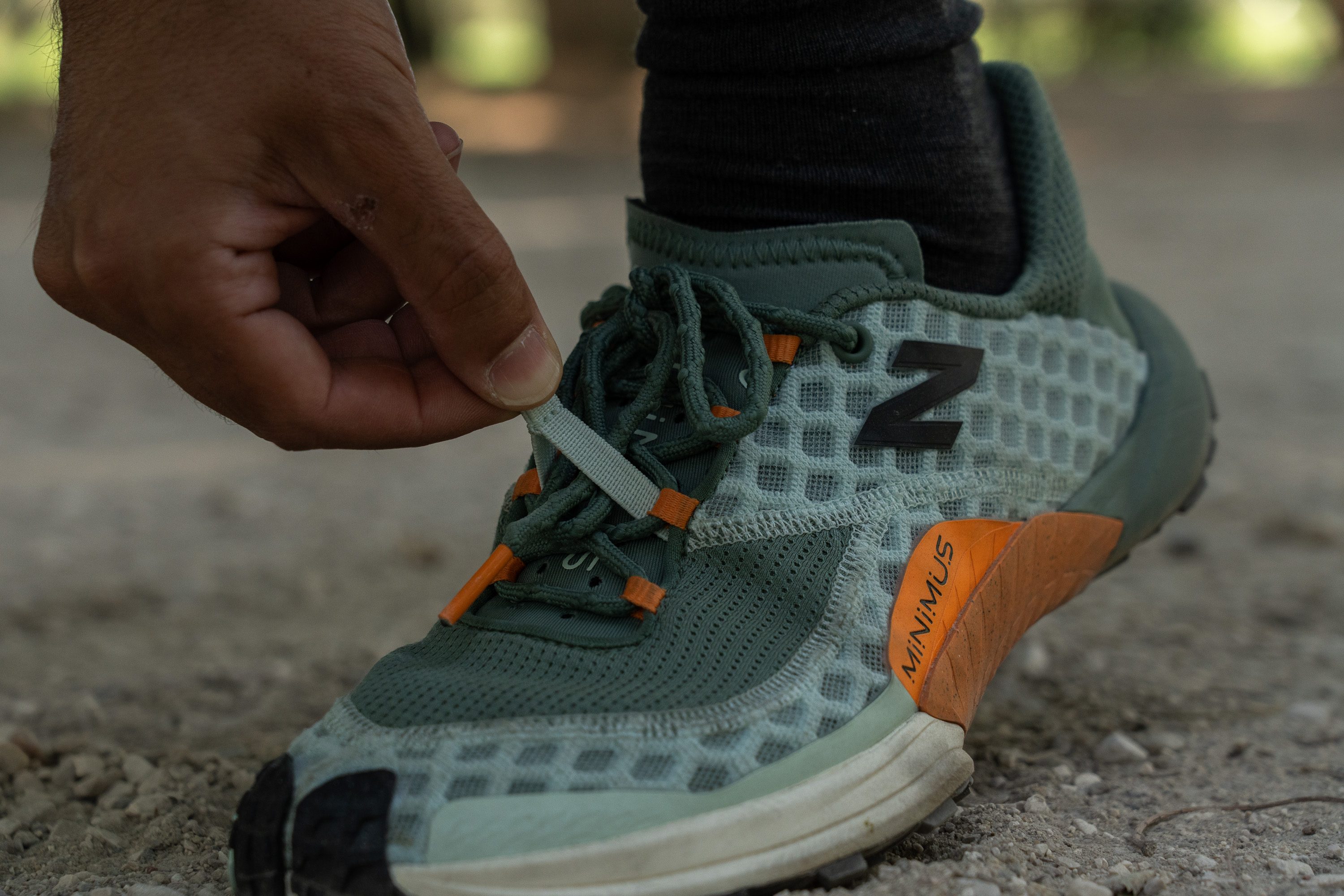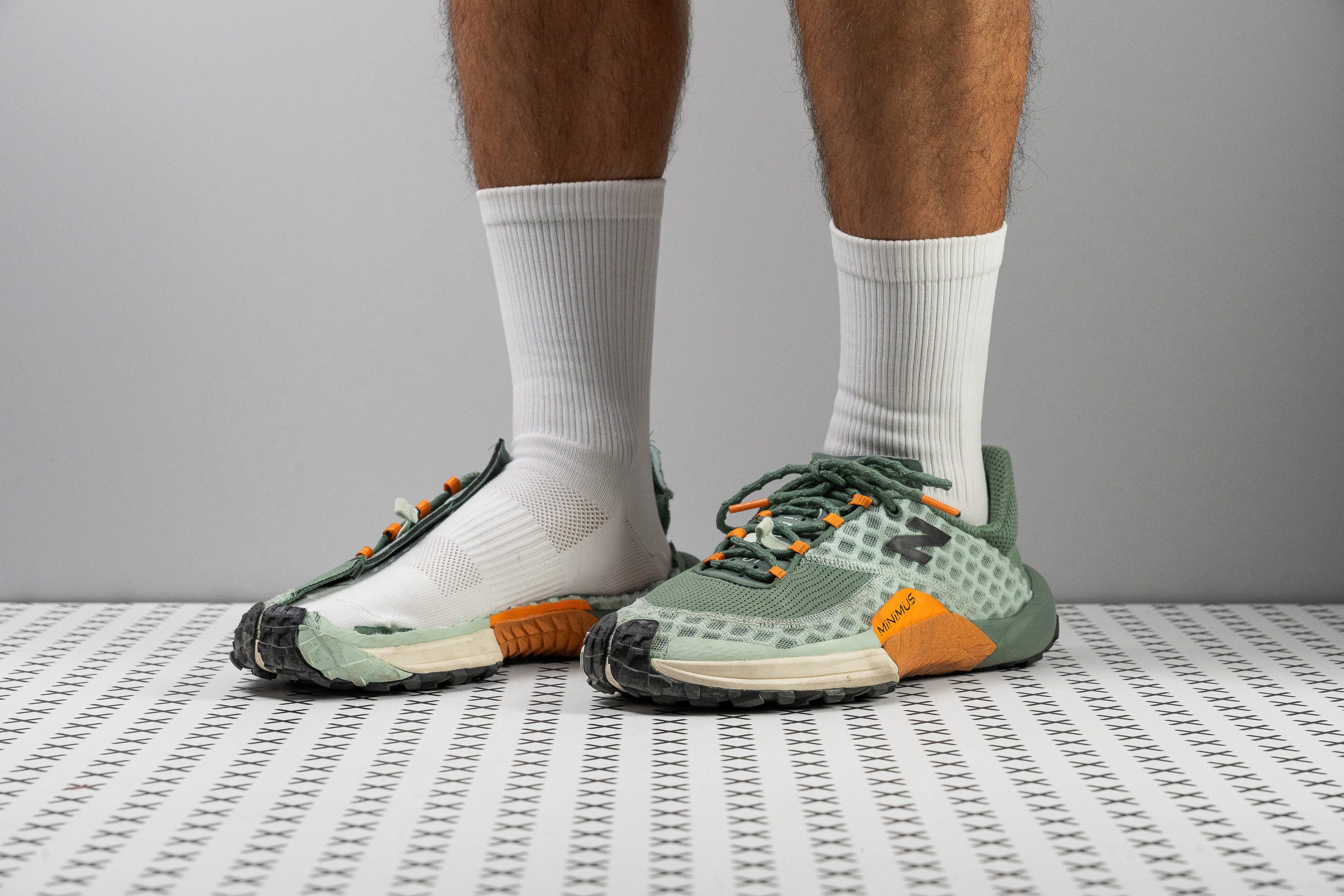Our verdict
Pros
- Outstanding durability
- Bends like a yoga teacher
- FuelCell foam delivers good bounce
- Reasonably priced
- Great for transitioning towards barefoot shoes
- Ideal for heel strikers
- Bold design
- Works wonders for hiking too
Cons
- Moderate drop won't fit everyone's needs
- Heel rocker can feel unnatural
- Narrow, tapered toebox limits toe splay
- Poor grip
Audience verdict
Comparison
The most similar running shoes compared
+ + Add a shoe | |||||
|---|---|---|---|---|---|
| Audience score | 73 Bad! | 88 Great! | 93 Superb! | 84 Good! | |
| Price | £130 | £130 | £180 | £180 | |
| Trail terrain | Light | LightModerate | Light | Moderate | |
| Shock absorption | Low | - | Moderate | - | |
| Energy return | Moderate | - | Moderate | - | |
| Traction | Moderate | - | - | - | |
| Arch support | Neutral | Neutral | Neutral | Neutral | |
| Weight lab Weight brand | 7.5 oz / 213g 7.9 oz / 224g | 9.9 oz / 282g 9.9 oz / 280g | 7.5 oz / 214g 7.1 oz / 200g | 7.5 oz / 213g 8 oz / 227g | |
| Lightweight | ✓ | ✗ | ✓ | ✓ | |
| Drop lab Drop brand | 5.2 mm 4.0 mm | 6.0 mm 6.0 mm | 8.6 mm 6.0 mm | 7.2 mm 5.0 mm | |
| Strike pattern | Mid/forefoot | Mid/forefoot | Mid/forefoot | Mid/forefoot | |
| Size | Slightly small | Slightly small | True to size | Slightly small | |
| Midsole softness | Soft | Soft | Balanced | Soft | |
| Difference in midsole softness in cold | Big | Small | Normal | Big | |
| Plate | ✗ | Rock plate | ✗ | ✗ | |
| Toebox durability | Very good | Decent | Decent | Very bad | |
| Heel padding durability | Good | Good | Decent | Good | |
| Outsole durability | Good | Good | Decent | Decent | |
| Breathability | Moderate | Moderate | Warm | Moderate | |
| Width / fit | Narrow | Medium | Medium | Narrow | |
| Toebox width | Medium | Wide | Medium | Medium | |
| Stiffness | Flexible | Stiff | Flexible | Stiff | |
| Torsional rigidity | Flexible | Flexible | Moderate | Moderate | |
| Heel counter stiffness | Flexible | Flexible | Flexible | Flexible | |
| Lug depth | 3.3 mm | 3.9 mm | 3.0 mm | 3.7 mm | |
| Heel stack lab Heel stack brand | 19.5 mm | 30.1 mm 29.0 mm | 25.0 mm 23.5 mm | 29.8 mm 30.0 mm | |
| Forefoot lab Forefoot brand | 14.3 mm | 24.1 mm 23.0 mm | 16.4 mm 17.5 mm | 22.6 mm 25.0 mm | |
| Widths available | NormalWide | NormalWide | Normal | Normal | |
| Season | All seasons | All seasons | All seasons | All seasons | |
| Removable insole | ✗ | ✓ | ✗ | ✓ | |
| Orthotic friendly | ✗ | ✓ | ✗ | ✓ | |
| Ranking | #363 Bottom 2% | #142 Top 39% | #4 Top 2% | #227 Bottom 38% | |
| Popularity | #229 Bottom 38% | #326 Bottom 12% | #267 Bottom 28% | #306 Bottom 17% |
Who should buy
We believe the New Balance Minimus Trail is ideal for:
- Runners with narrow feet who find barefoot-style shoes too spacious.
- Trail runners seeking a minimalist option without zero-drop geometry.
- Individuals transitioning toward barefoot shoes who prefer an in-between step with some midsole cushioning.
- Heel strikers looking for a minimalist shoe with amazing durability.
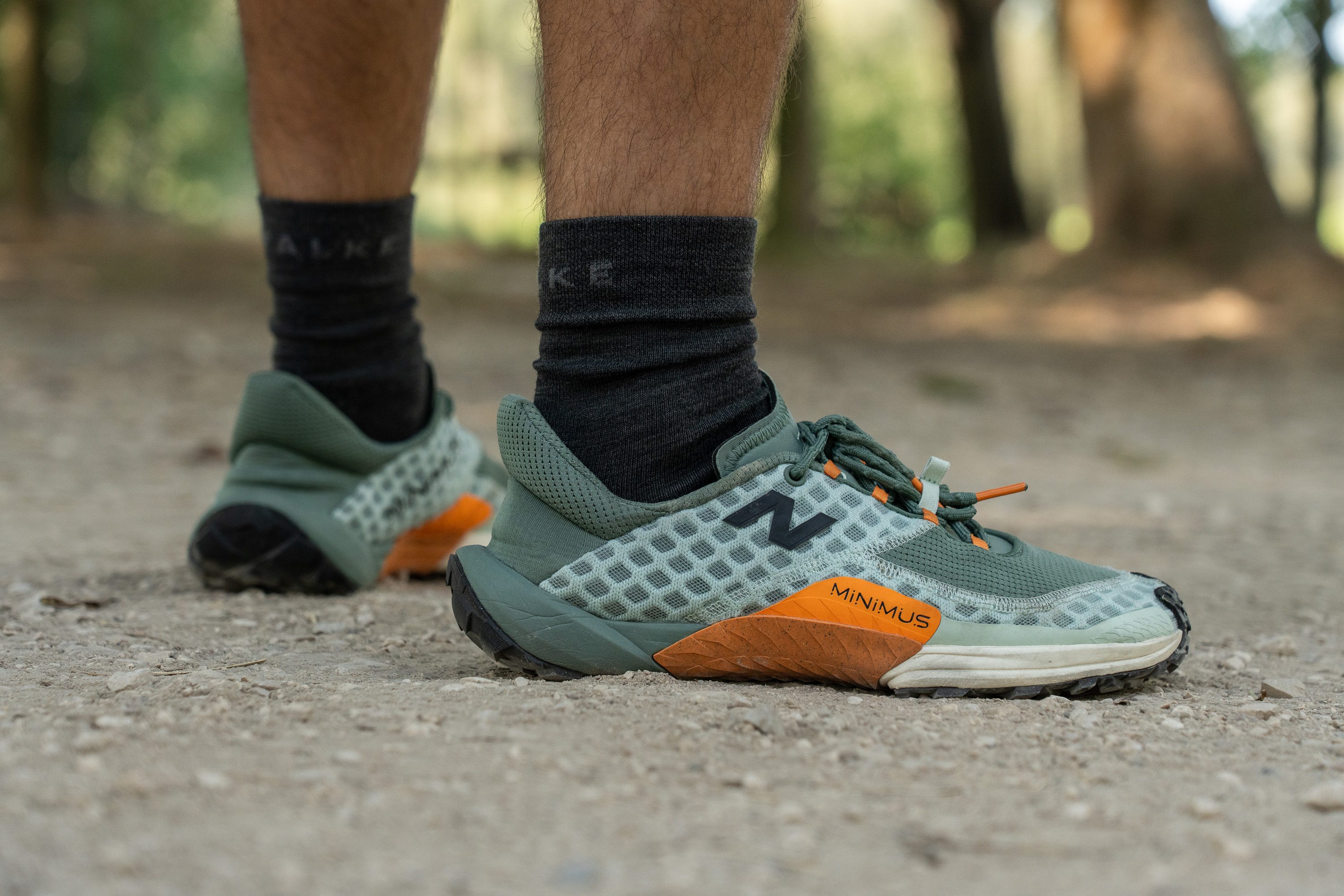
Who should NOT buy
We think the New Balance Minimus Trail isn’t the best choice for runners who need a roomy toebox. Our evaluation shows a narrow, tapered forefoot that feels far from the wide-open comfort seen in other minimalist shoes. For those concerned about this fit, we believe that the Xero Shoes Scrambler Low is a better pick.
Additionally, we found the moderate drop of the Minimus Trail can be a deal-breaker for some. In our view, this offset doesn’t fully match the expectations of minimalists aiming for a natural stride. For a zero-drop alternative, we recommend looking at the Merrell Trail Glove 7, which maintains a very similar concept but with a flat midsole.
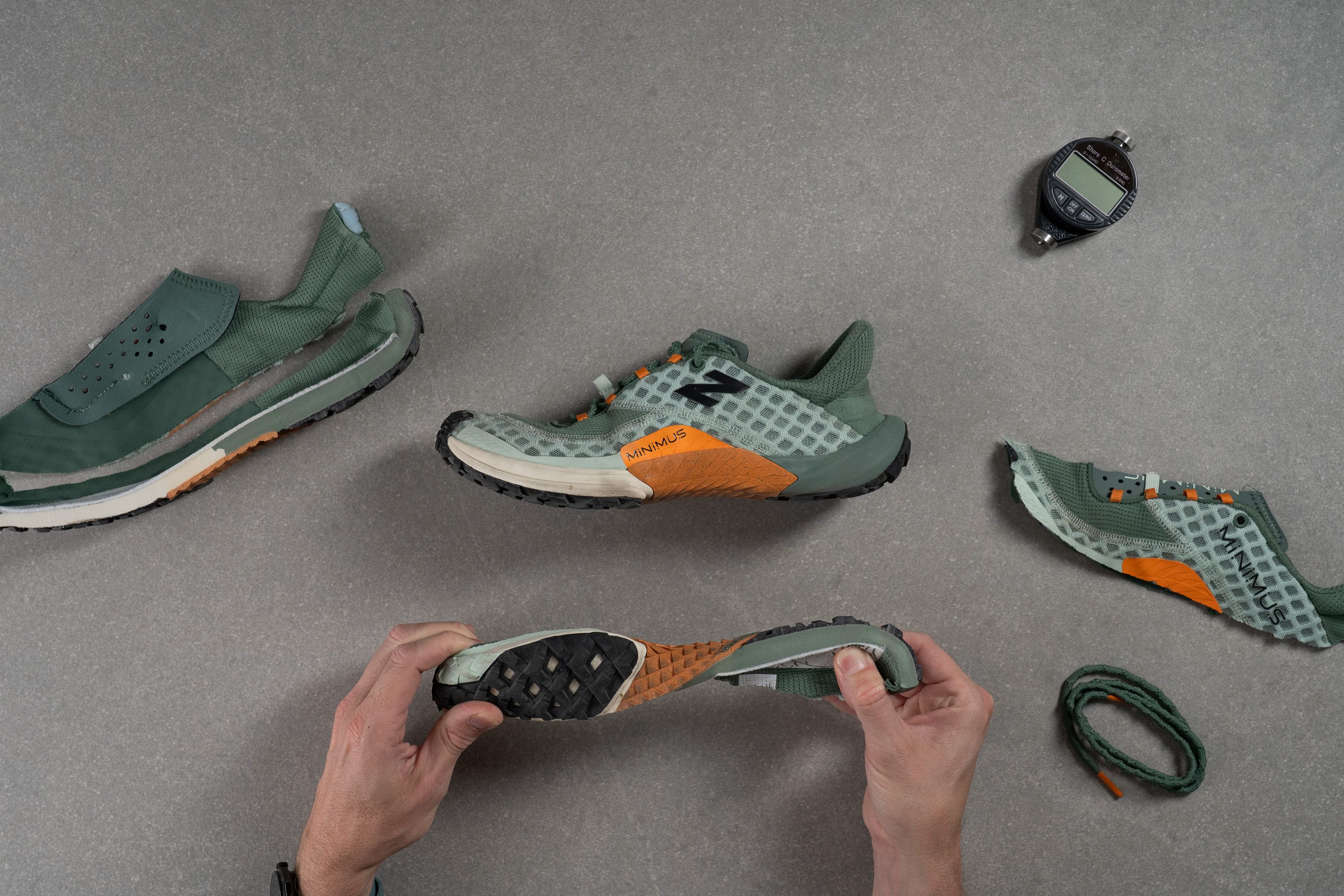
Cushioning
Shock absorption
Shock absorption is very limited on the Minimus Trail, but that’s exactly what you’d expect from a minimalist shoe.
We measured 76 SA in the heel and 77 SA in the forefoot, confirming that your body will absorb a significant amount of impact while maintaining a strong connection with the ground.
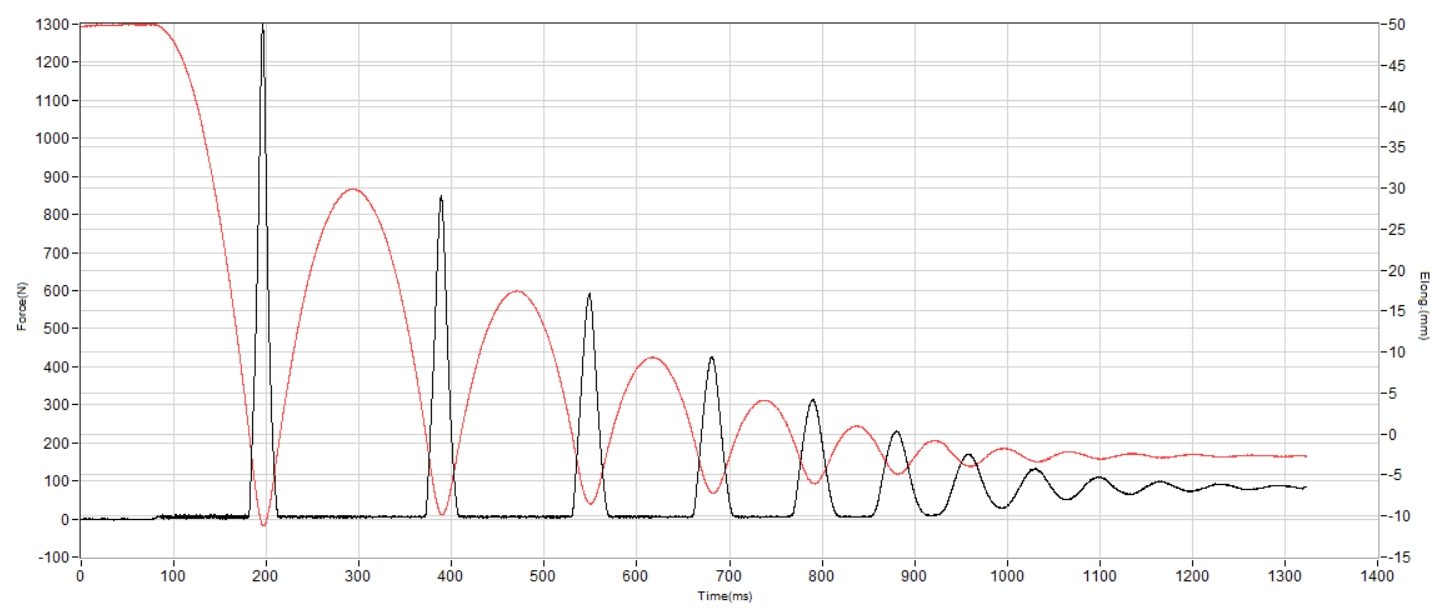
| Minimus Trail | 76 SA |
| Average | 122 SA |
Energy return
Energy return reaches 62.6% in the heel and 64.9% in the forefoot, impressive figures for a minimalist shoe that deliver solid responsiveness for runners who enjoy picking up the pace in the Minimus.
But is this surprising? Not for us. The Minimus uses FuelCell foam even though it doesn’t carry the name like most other New Balance shoes.
| Minimus Trail | 62.6% |
| Average | 55.6% |
Heel stack
A true minimalist shoe must have a low stack height, and that’s non-negotiable. With just 19.5 mm in the heel, the Minimus Trail fits squarely into this category.
But is it the right choice for you? That depends on your preferences. This is a completely different experience compared to traditional trail shoes like the New Balance Fresh Foam X Hierro v9. Here you get only a touch of cushioning, and the focus is on delivering a natural ride that’s lightly filtered but nothing beyond that.
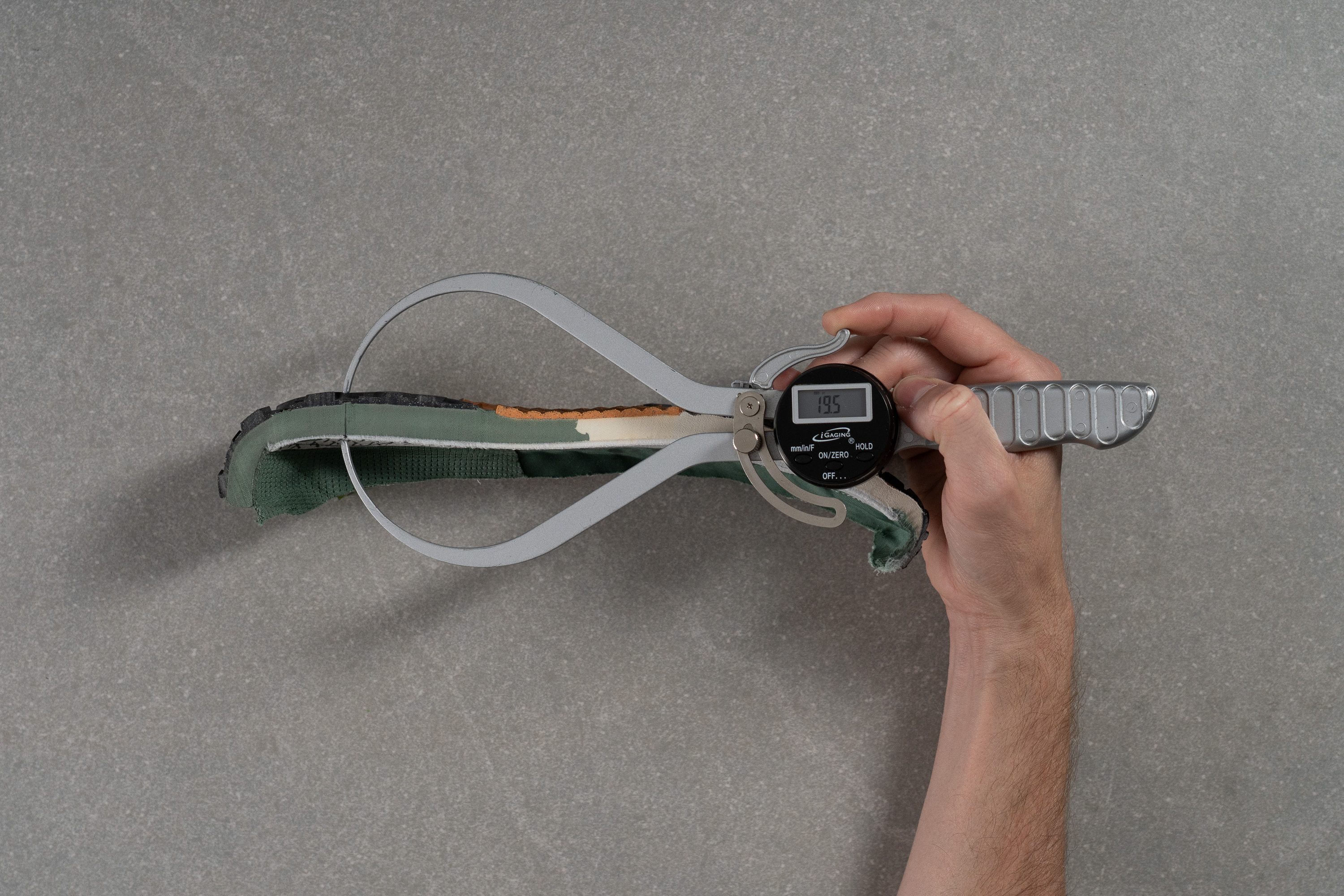
| Minimus Trail | 19.5 mm |
| Average | 32.6 mm |
Forefoot stack
The forefoot stack of the Minimus is even lower than the heel, placing you just 14.3 mm above the ground. Naturally, this means less protection from hazards like sharp stones, especially since the shoe skips a rock plate to maximise flexibility.
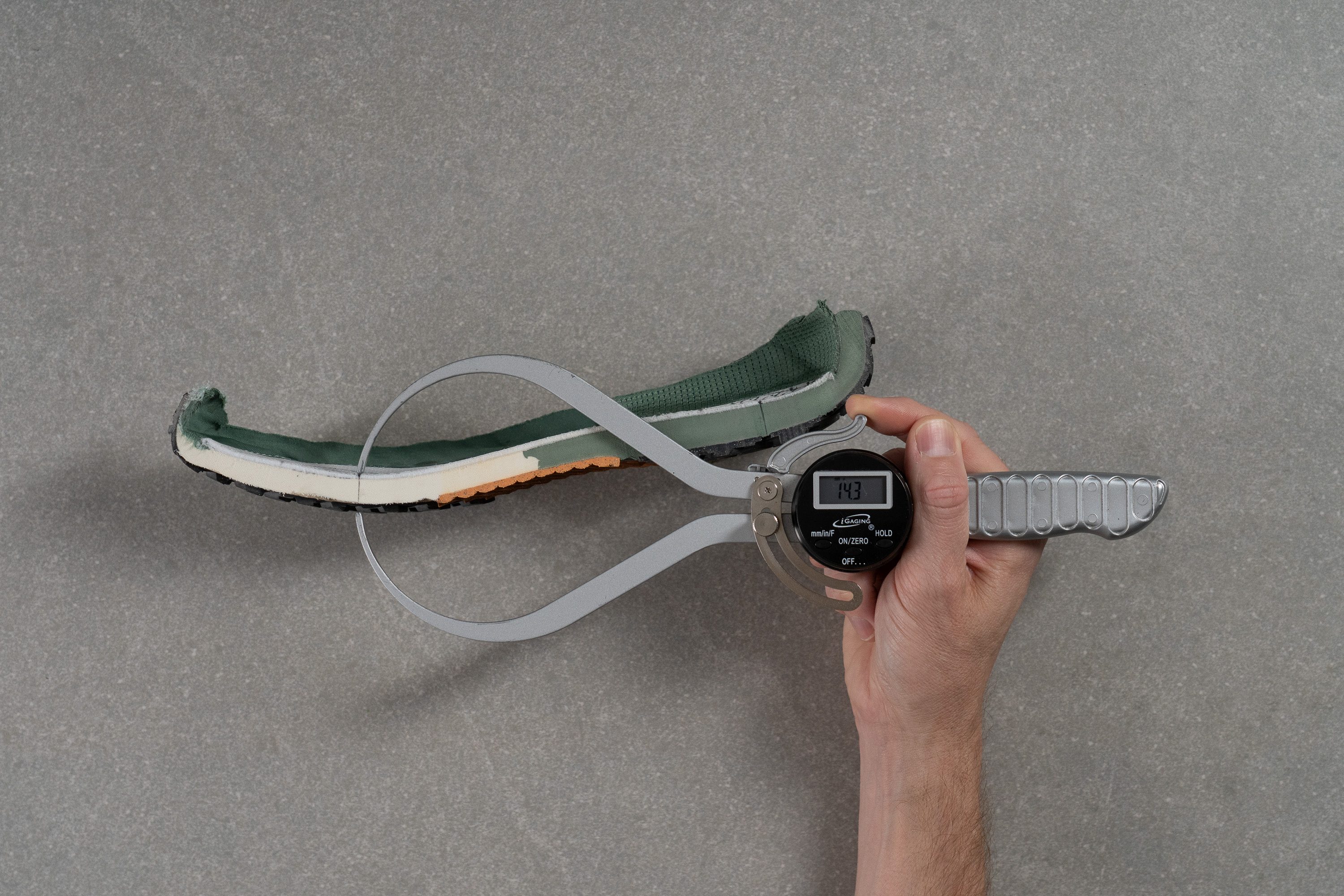
| Minimus Trail | 14.3 mm |
| Average | 25.1 mm |
Drop
This shoe is a great option for runners seeking a minimalist trail design without a zero-drop geometry.
While it skips a completely natural running feel, those with Achilles tendon concerns or heel strikers who appreciate a slight offset will likely prefer the Minimus Trail and its 5.2 mm drop.
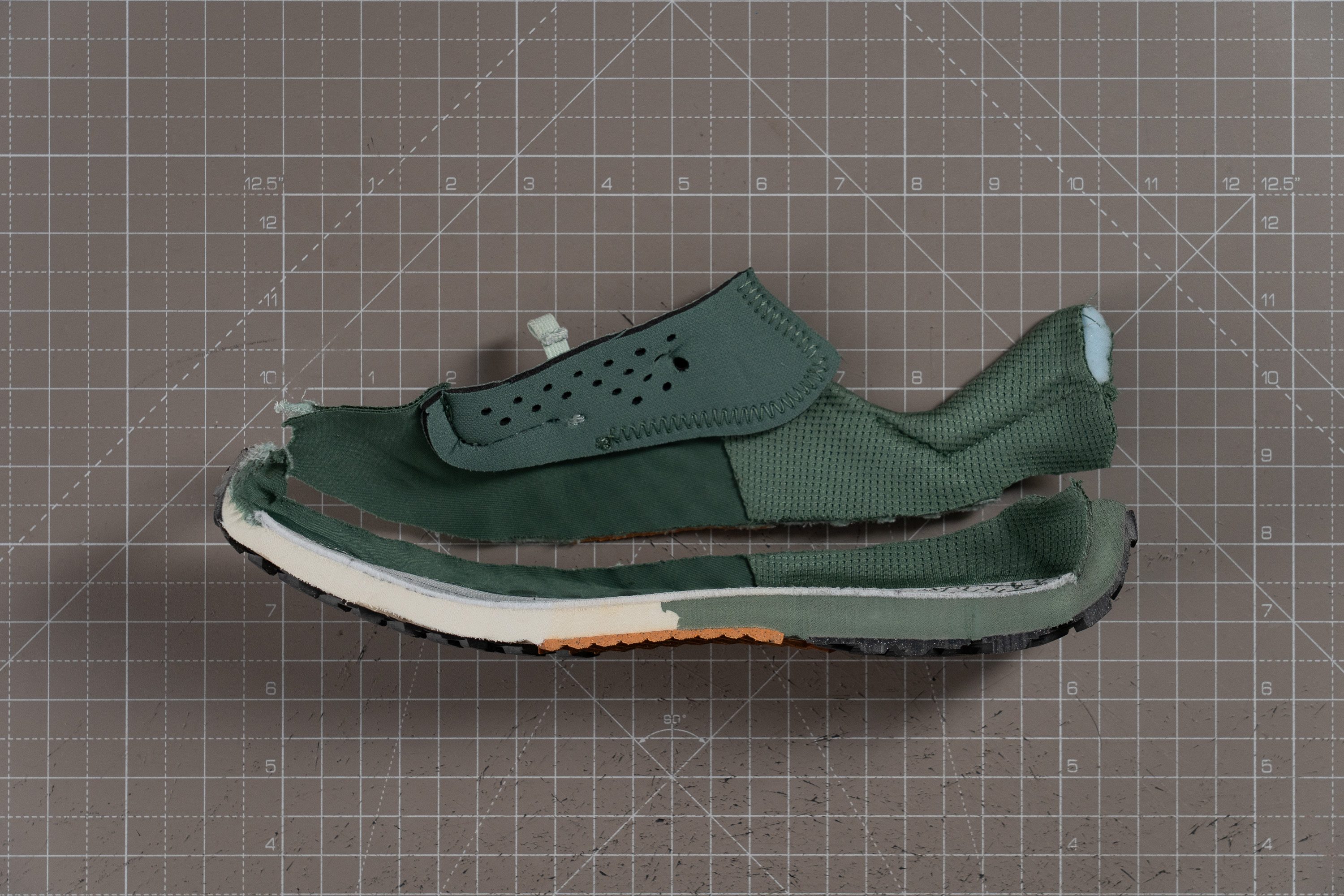
| Minimus Trail | 5.2 mm |
| Average | 7.6 mm |
Midsole softness
The thin FuelCell layer in the Minimus measures 15.6 HA in softness in the heel area. Interestingly, most minimalist shoes rely on firmer foams, but New Balance stays consistent with its recent lineup and delivers its signature plush feel here as well.
However, this softness means you bottom out on the outsole fairly quickly, which is to be expected in a minimalist shoe.
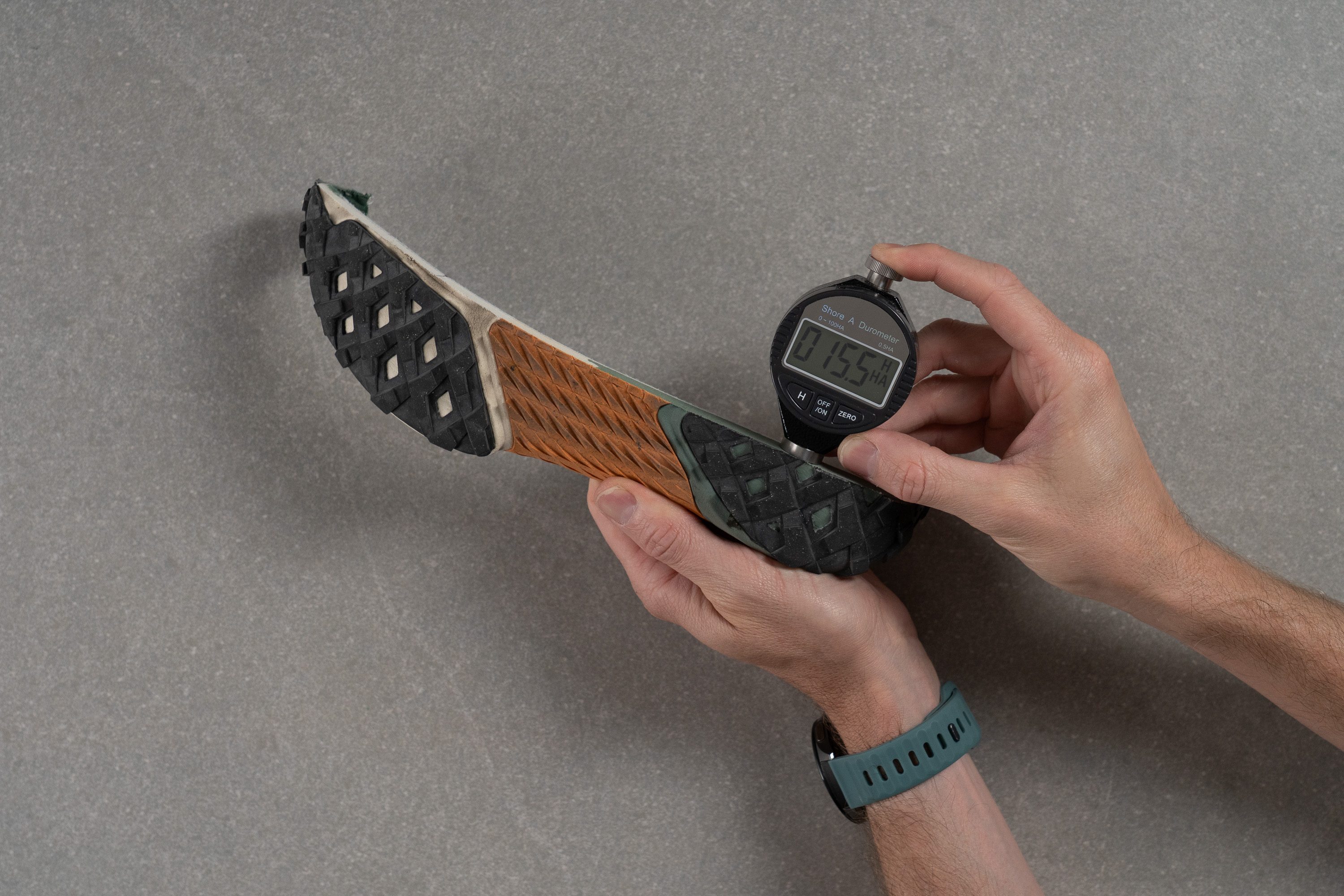
| Minimus Trail | 15.6 HA |
| Average | 21.9 HA |
Secondary foam softness
The forefoot uses a firmer FuelCell formulation at 19.5 HA. This feels like a smart approach, providing softer cushioning in the higher heel and slightly firmer foam in the thinner forefoot for balance.
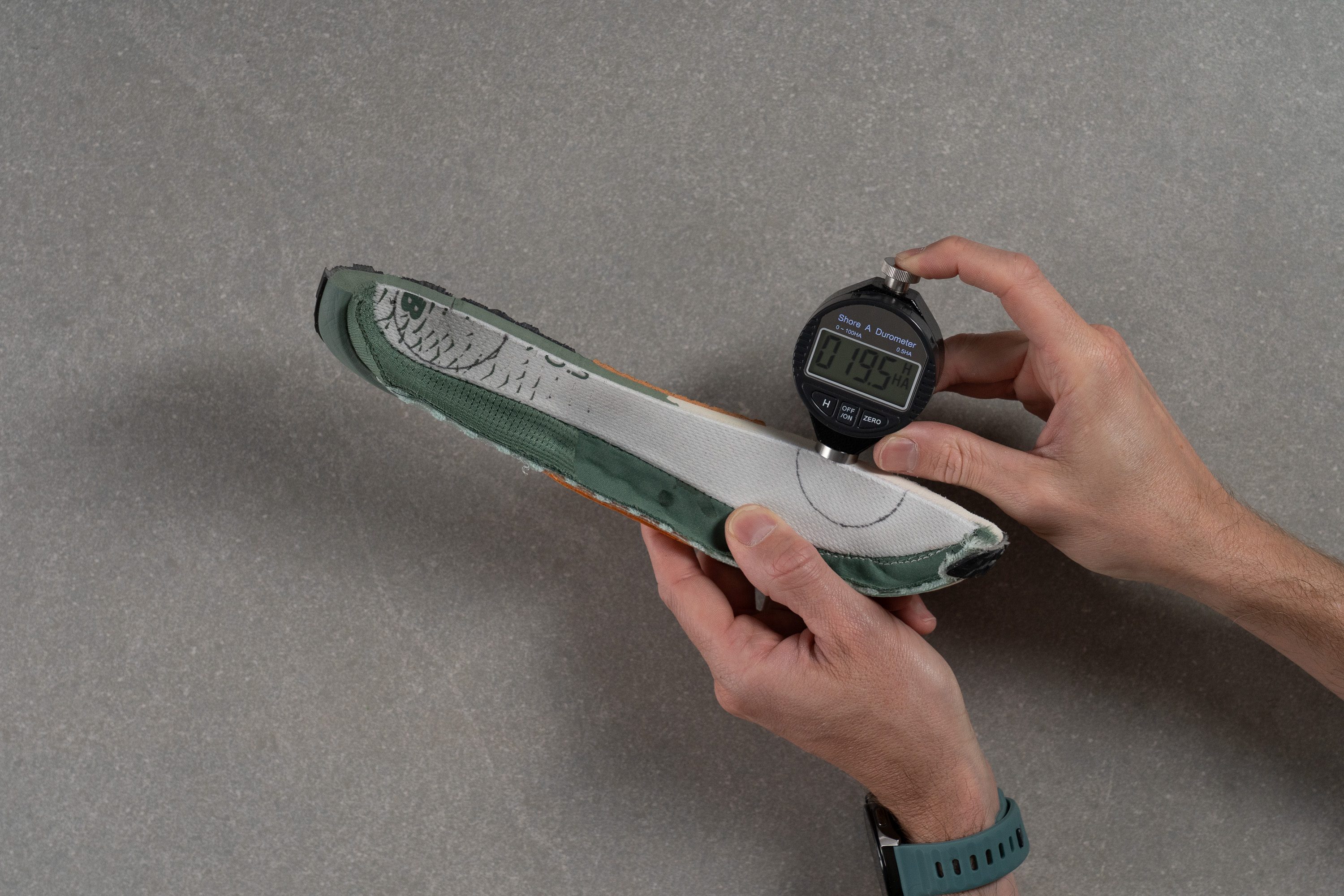
| Minimus Trail | 19.5 HA |
| Average | 25.5 HA |
Rocker
The Minimus Trail introduces a rocker geometry that is unusual for a minimalist shoe. Most models in this category feature a flat platform, but here the heel shows a distinct upward curvature. This design slightly eases heel impact and creates a smoother transition forward, and it's definitely ideal for heel strikers.
In addition, the forefoot has a mild rocker that encourages a quicker toe-off. This combination makes the Minimus Trail stand out, blending minimalist principles with a subtle rolling motion typically found in higher-stack shoes. However, for runners seeking a true minimalist or barefoot-like experience, this rockered shape will not meet those expectations at all.
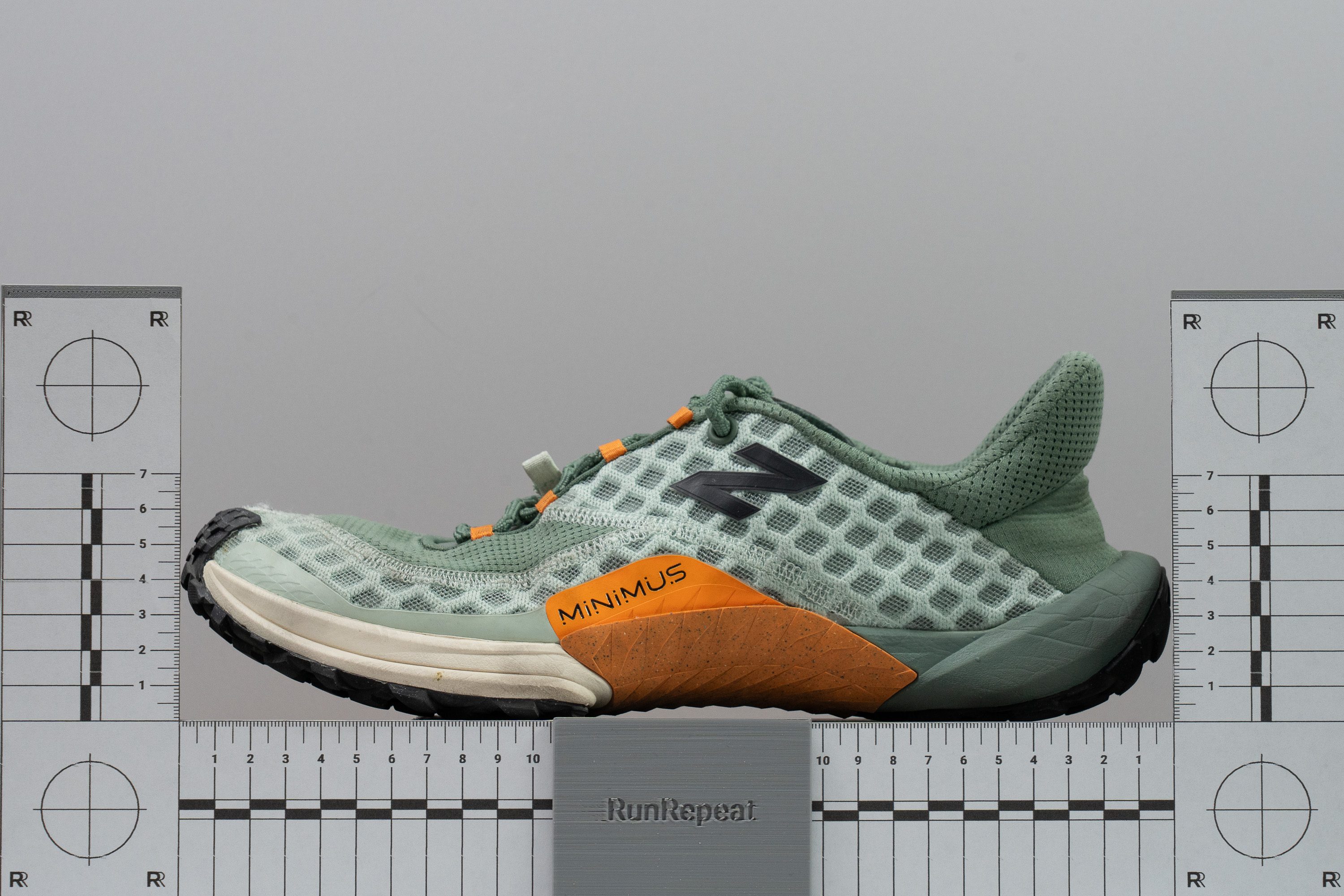
Size and fit
Size
New Balance Minimus Trail fits slightly small (66 votes).
Width / Fit
The Minimus Trail is unusual because it doesn’t use a foot-shaped toebox, which can feel confusing for some in serach of a minimalist shoe. But this not a barefoot design, as those are two very different concepts that are often mixed up.
When we tested it, we discovered a narrow width of 91.2 mm, showing that the shoe goes for a close, glove-like fit instead of a roomy design.
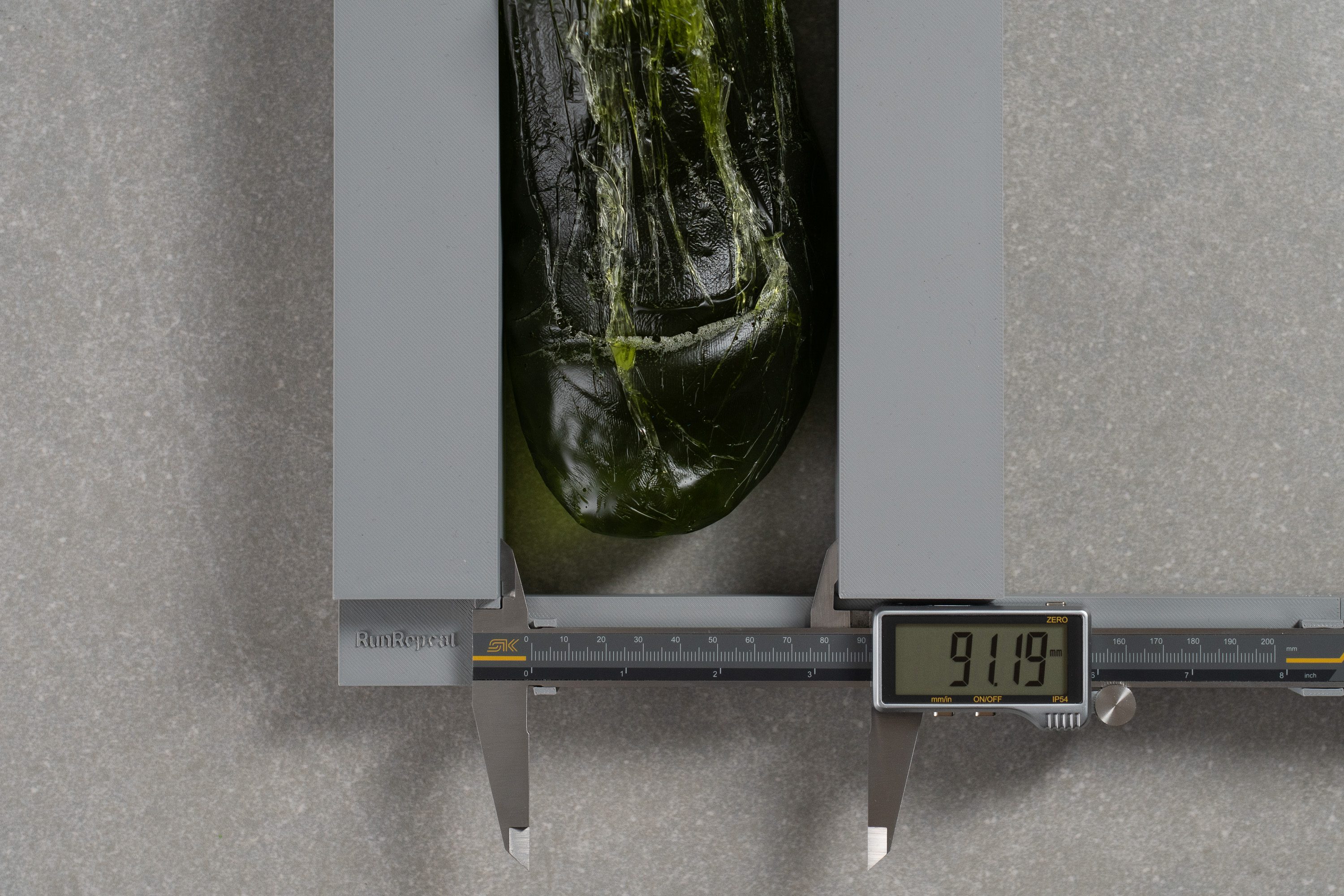
| Minimus Trail | 91.2 mm |
| Average | 95.6 mm |
Toebox width
The real proof that this shoe lacks a foot-shaped toebox comes here.
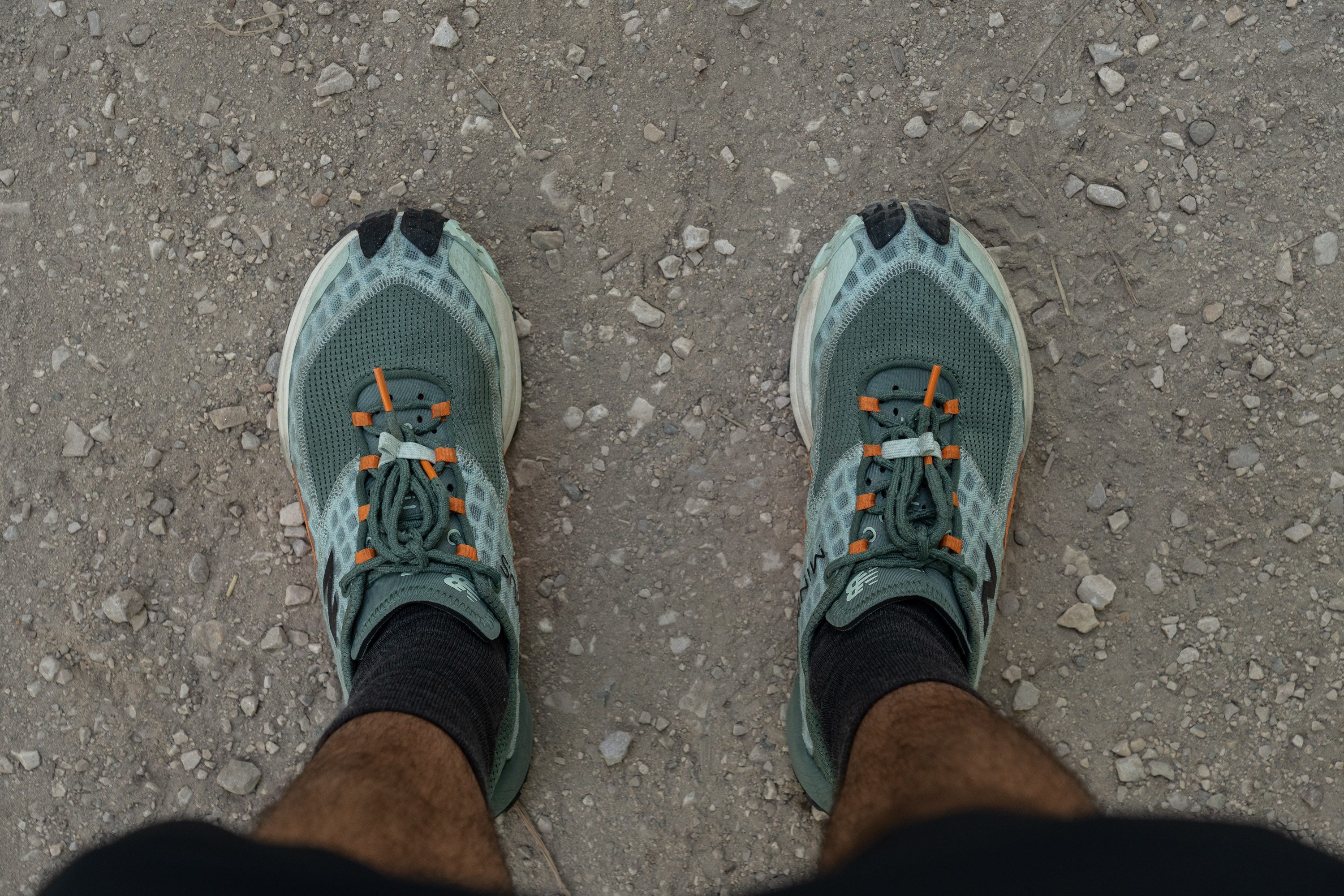
A model that provides excellent space for most foot shapes should measure at least 80 mm here, but we recorded only 72.3 mm. That said, it's absolutely ideal for those with narrow feet.
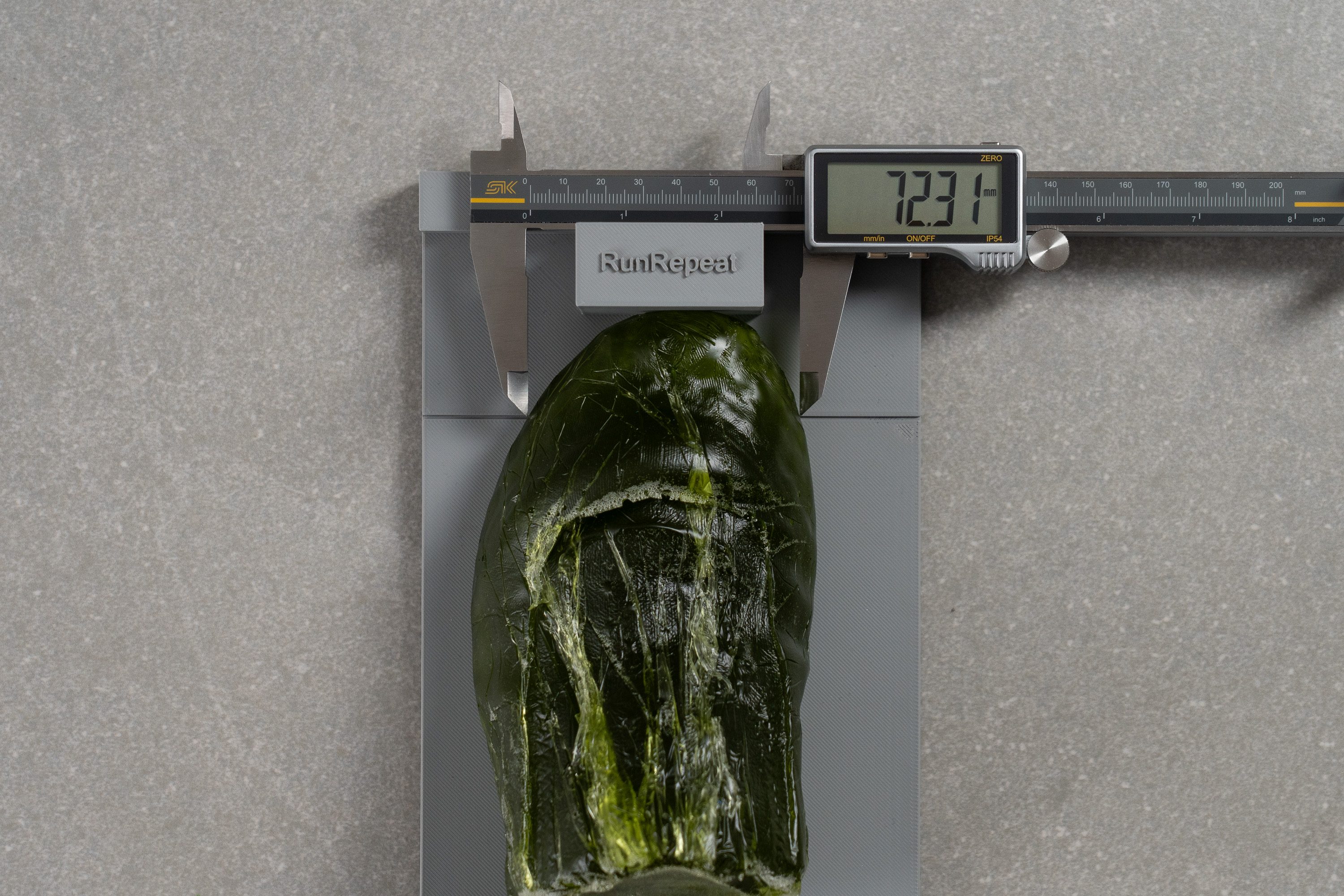
| Minimus Trail | 72.3 mm |
| Average | 74.6 mm |
Toebox height
The toebox offers generous vertical space for the toes, so there are no concerns for anyone in this area.
In fact, our final measurement before setting the gel mould aside showed 28.0 mm, which is above average.
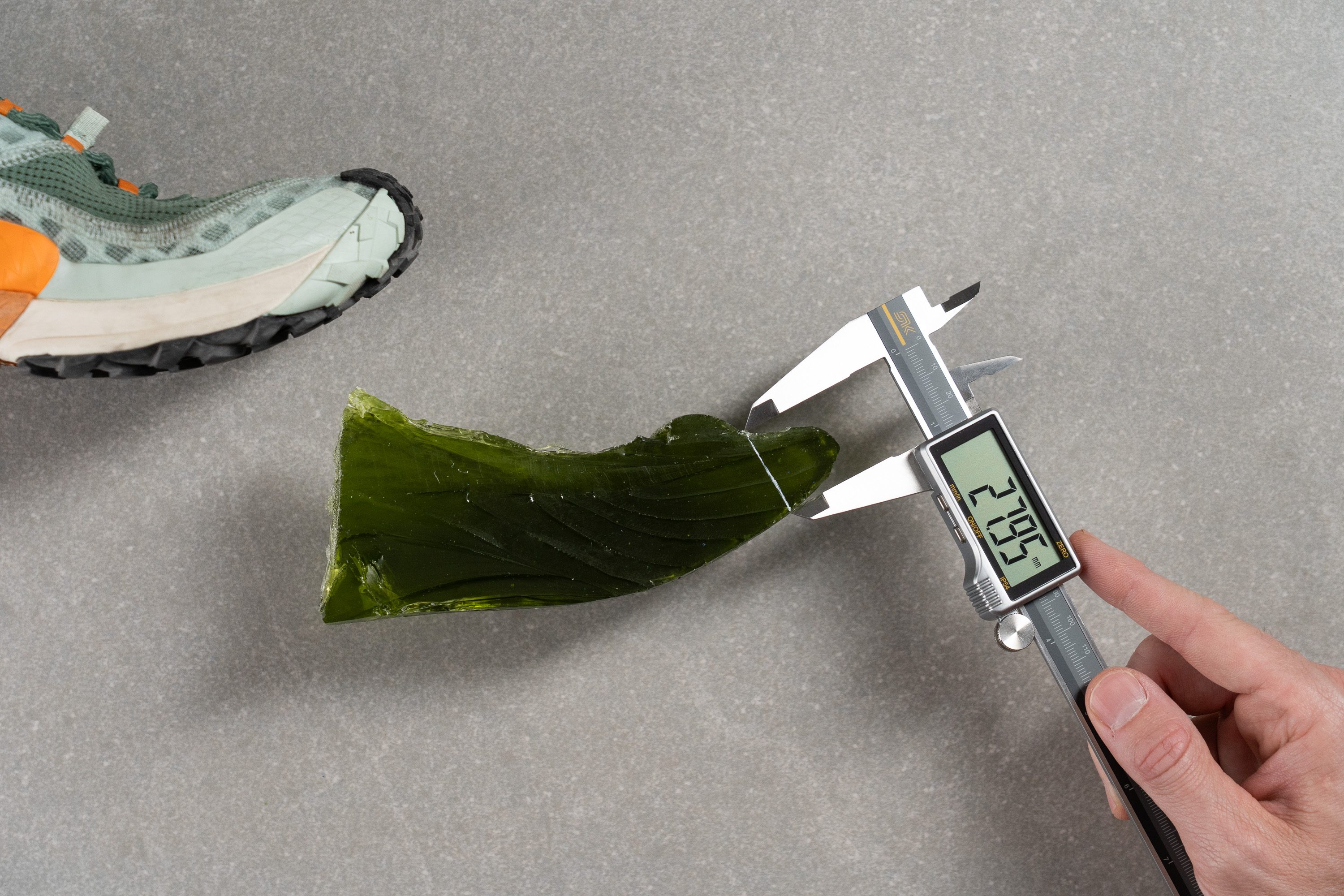
| Minimus Trail | 28.0 mm |
| Average | 27.0 mm |
Traction / Grip
Forefoot traction
One area where the Minimus truly let us down is traction. We expected better than the 0.35 score from our grip test, a result that raises real concerns in tough conditions and clearly shows that future versions need meaningful improvement.
| Minimus Trail | 0.35 |
| Average | 0.60 |
Lug depth
The Minimus Trail handles easy to moderate trails well with its 3.3 mm lugs, but it’s not designed for mud or technical terrain. In our view, it feels best suited for places like coastal trails, fire roads, or smooth groomed paths.
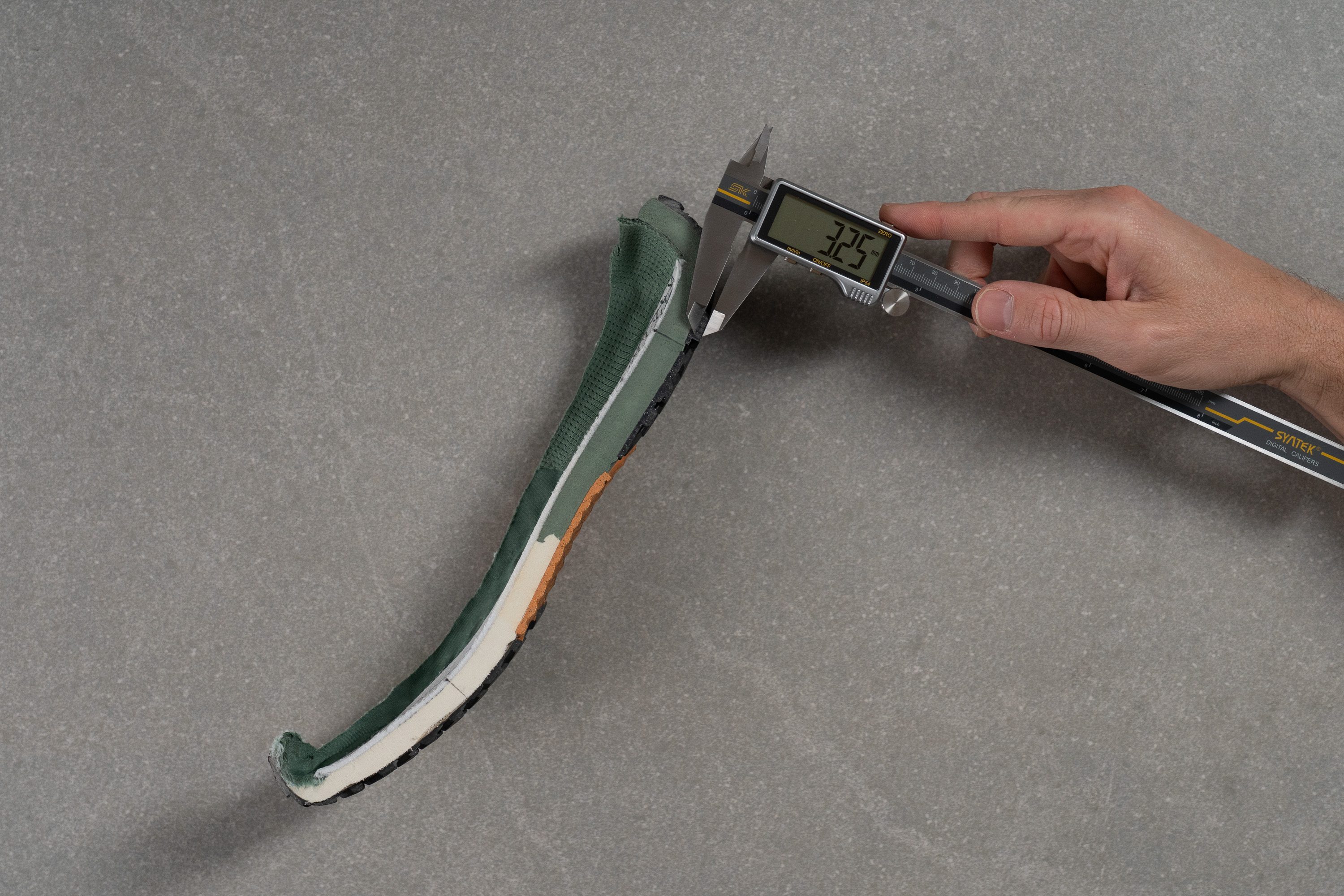
| Minimus Trail | 3.3 mm |
| Average | 3.5 mm |
Outsole design
The outsole of the Minimus Trail is made from AT Tread rubber and features arrow-shaped lugs across the heel and forefoot, arranged in a diagonal grid with large cutouts that enhance flexibility.
The heel lugs are bigger and bevelled to form a rounded block, while the forefoot lugs are smaller and denser, optimised for toe-off and directional control. And what about the midfoot? It has a unique design that completely separates the two rubber sections, while small mini lugs are added to provide extra surface contact.
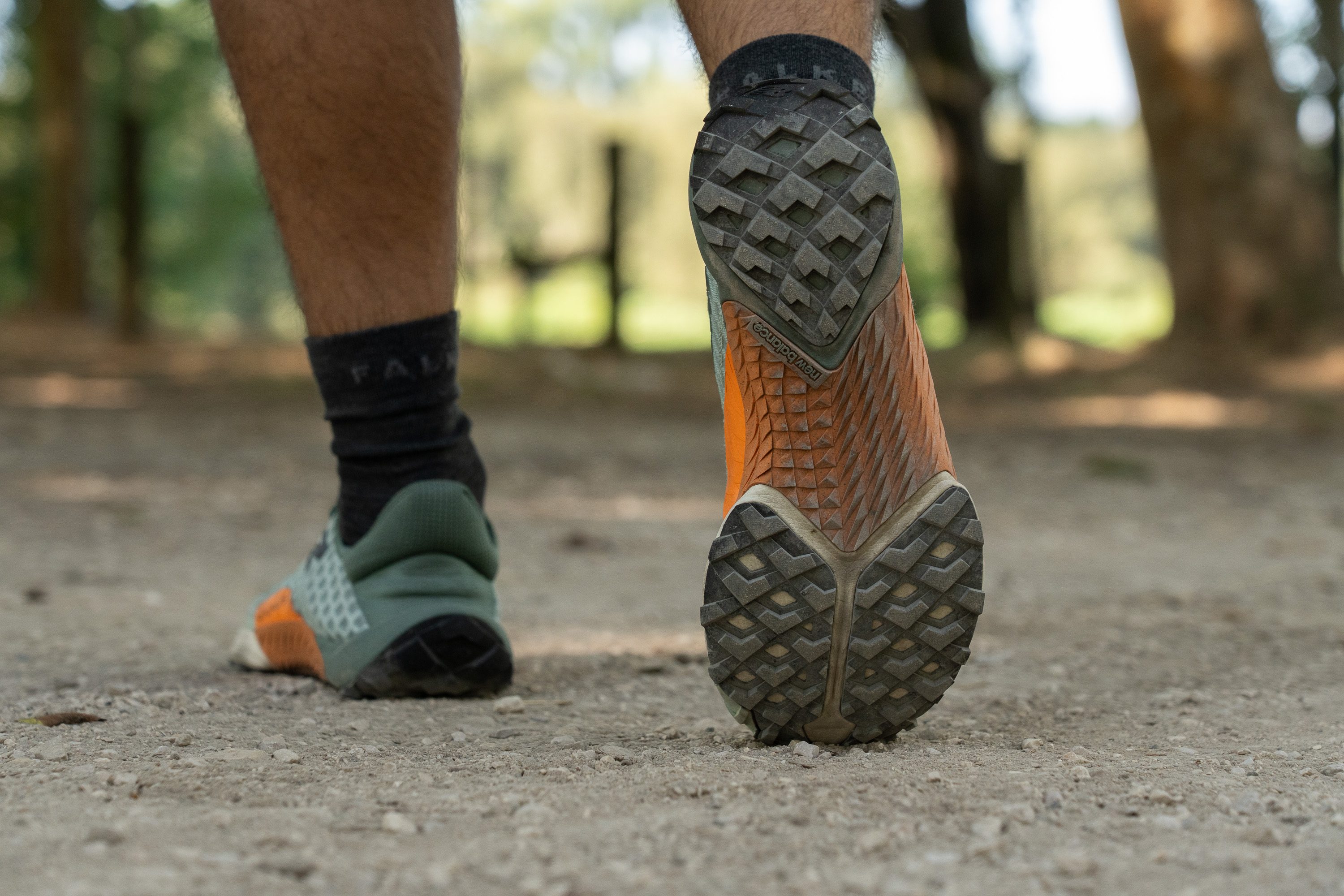
Flexibility / Stiffness
Another key requirement for any minimalist shoe is high flexibility, or low stiffness—call it what you prefer. The Minimus Trail delivers impressively, scoring just 3.5N in our 30-degree bend test.
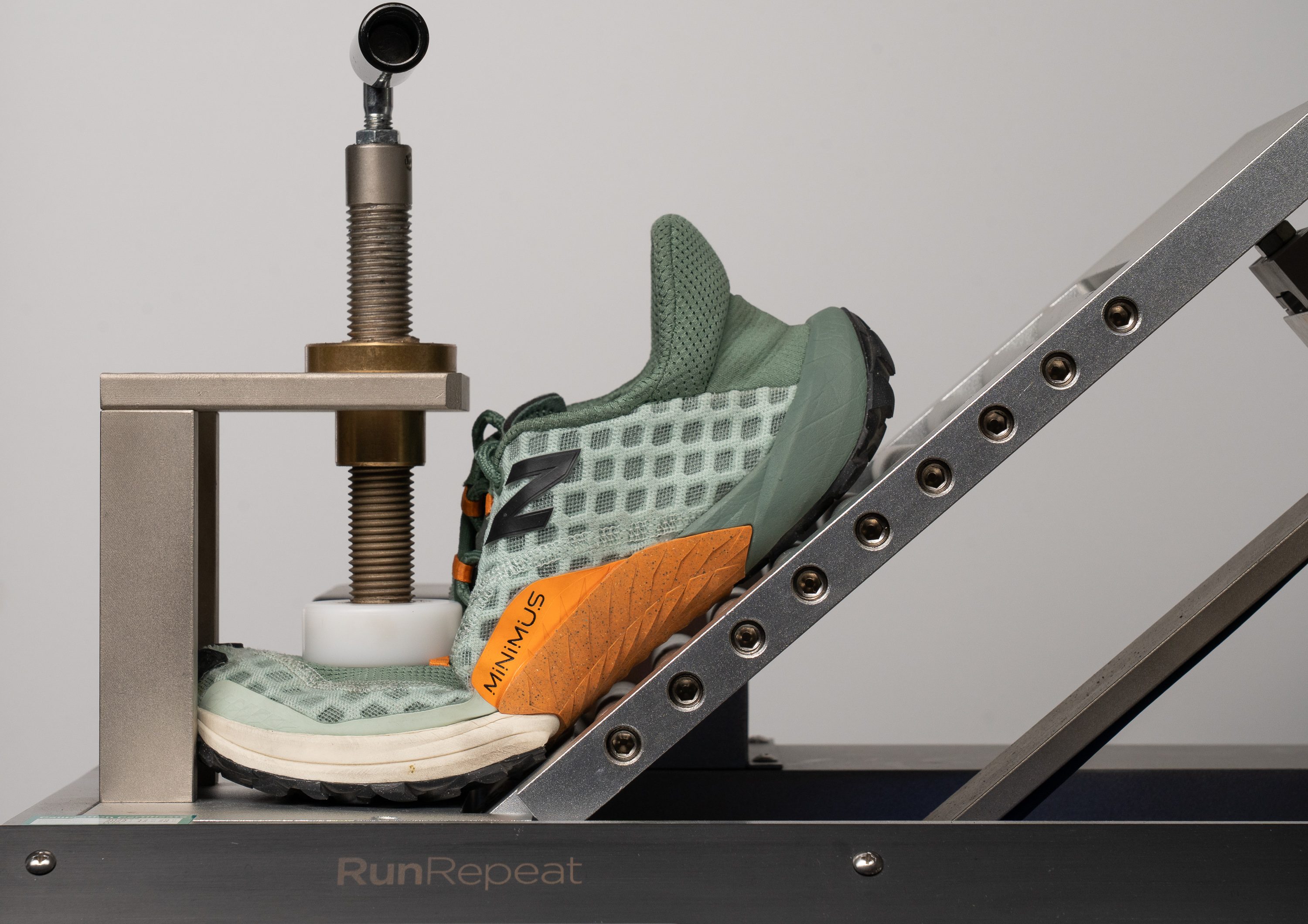
| Minimus Trail | 3.5N |
| Average | 14.6N |
Weight
Many runners assume minimalist shoes are always super light, but that’s not really the case. The mistake comes from thinking a lower stack cuts weight, yet modern foams are ultra-light and don’t add much bulk.
The Minimus Trail came in at 7.5 oz or 213g.
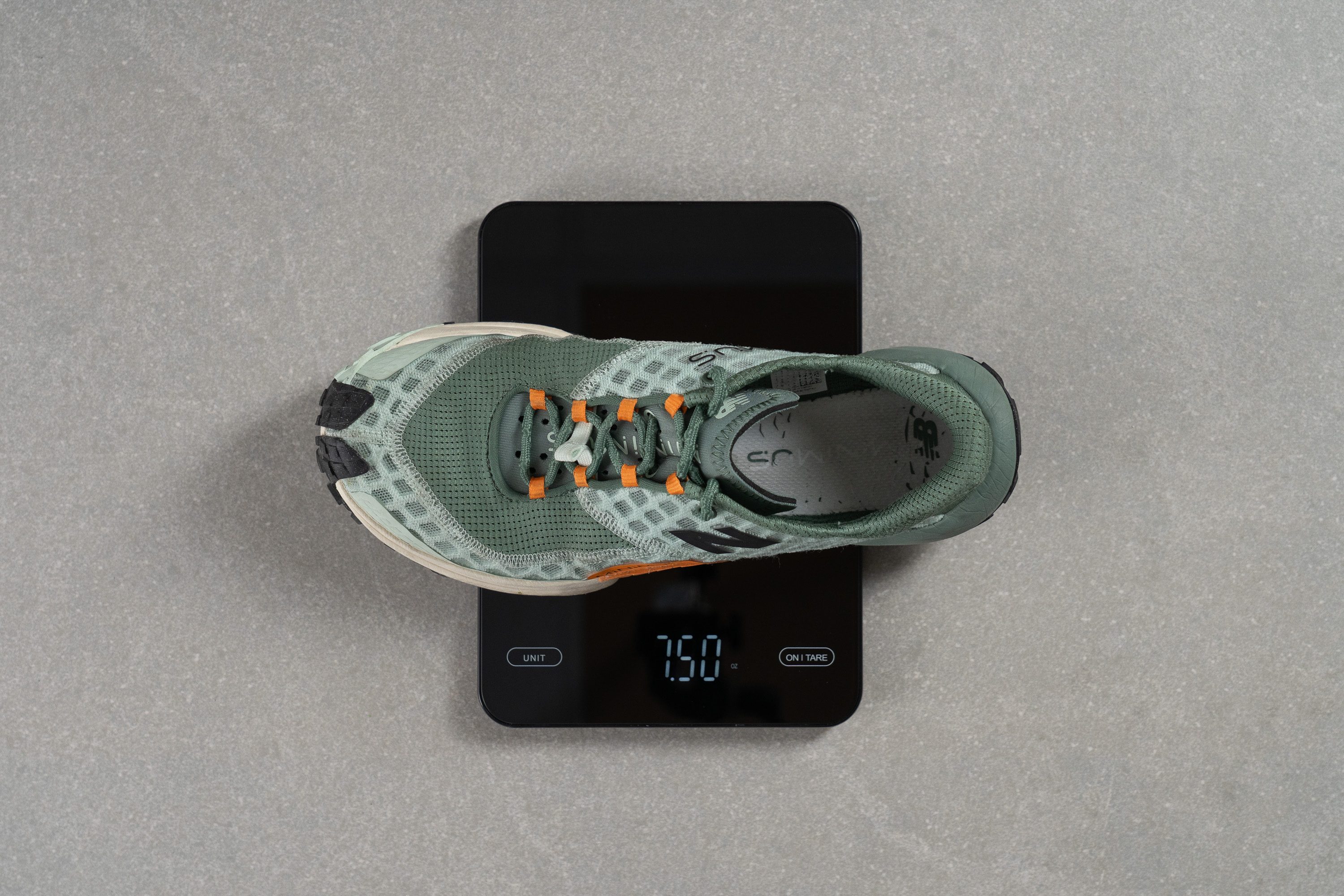
| Minimus Trail | 7.5 oz (213g) |
| Average | 10.2 oz (289g) |
Breathability
The upper of the New Balance Minimus Trail looks tough and trail-ready, but in the lab we questioned how breathable it really was.
When we tested it with our smoke-pumping machine, some smoke managed to escape, but much of it remained trapped inside. Based on this, we rated its breathability a 3/5.
Light testing confirmed the same result. No light passed through the material, showing that the upper is very dense with no big gaps. This is common in trail shoes, where brands often value other stuff over ventilation.
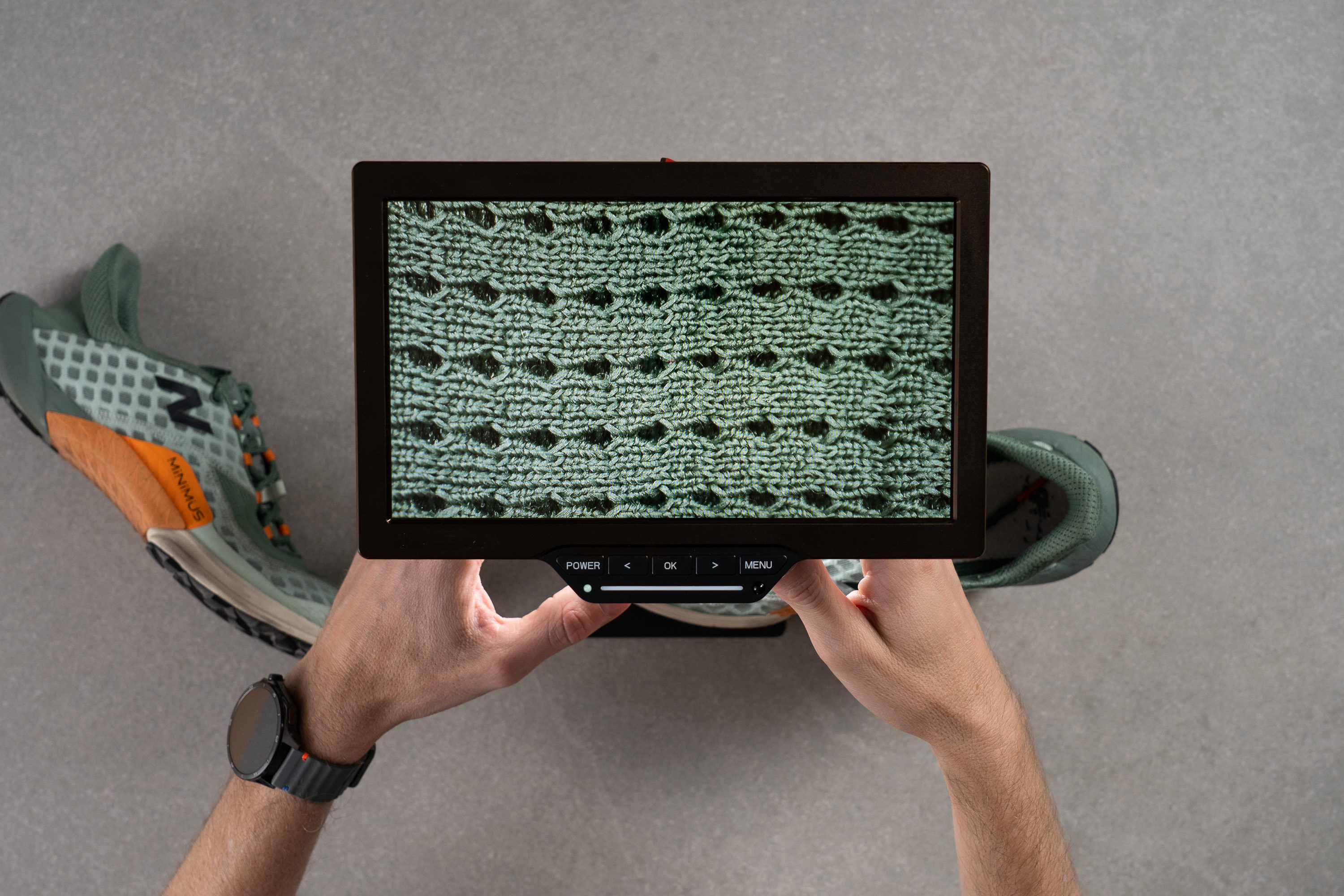
Under the microscope, we discovered plenty of small perforations, but these were blocked by a lower layer.
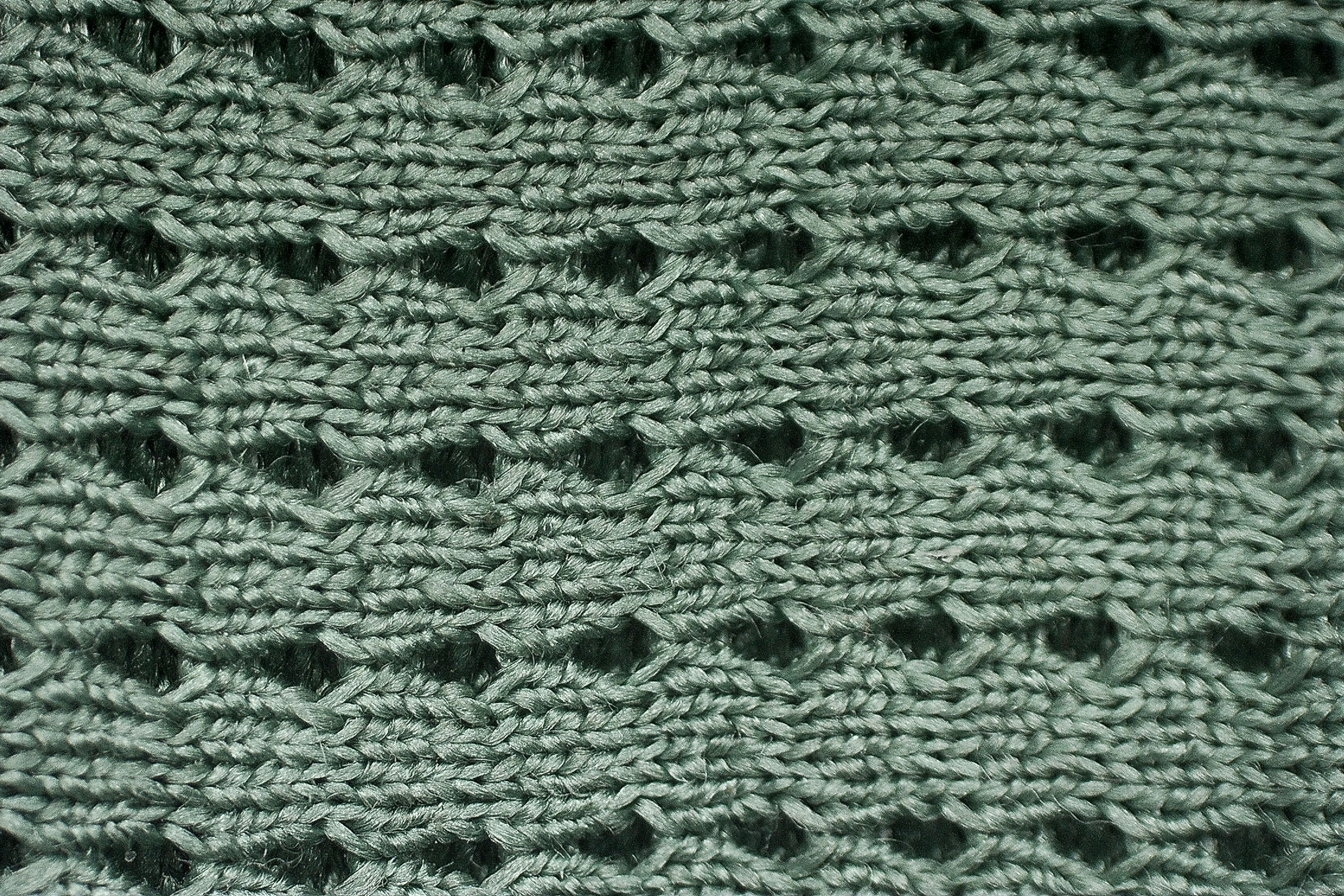
This explains why air movement was restricted despite the outer surface showing tiny holes.
We also found the design really unique. The upper combines different fabrics with bold, visible stitching that some may like and others may not. Still, comfort is protected, as the stitching is covered inside by the inner layer, preventing irritation during runs or hikes.
| Minimus Trail | 3 |
| Average | 3.2 |
Stability
Lateral stability test
One of the key benefits of minimalist shoes is the natural stability that comes from being closer to the ground.
Still, the Minimus Trail uses a very narrow platform, so stability is limited—much like its shock absorption—and most of the effort falls on the runner.
Torsional rigidity
This video clearly shows why the decoupled design of the Minimus Trail is effective. Scoring 1/5 in this test is essential for a minimalist shoe, and we were glad to confirm it.
| Minimus Trail | 1 |
| Average | 3.6 |
Heel counter stiffness
The heel counter is surprisingly flexible despite its appearance. For us, this is another positive trait in a shoe designed to feel natural on foot, especially since it combines added heel foam for comfort without creating a stiff heel section.
| Minimus Trail | 1 |
| Average | 3 |
Midsole width - forefoot
The forefoot measures 111.8 mm in width, though it appears wider at first glance because of the shoe’s narrow heel.
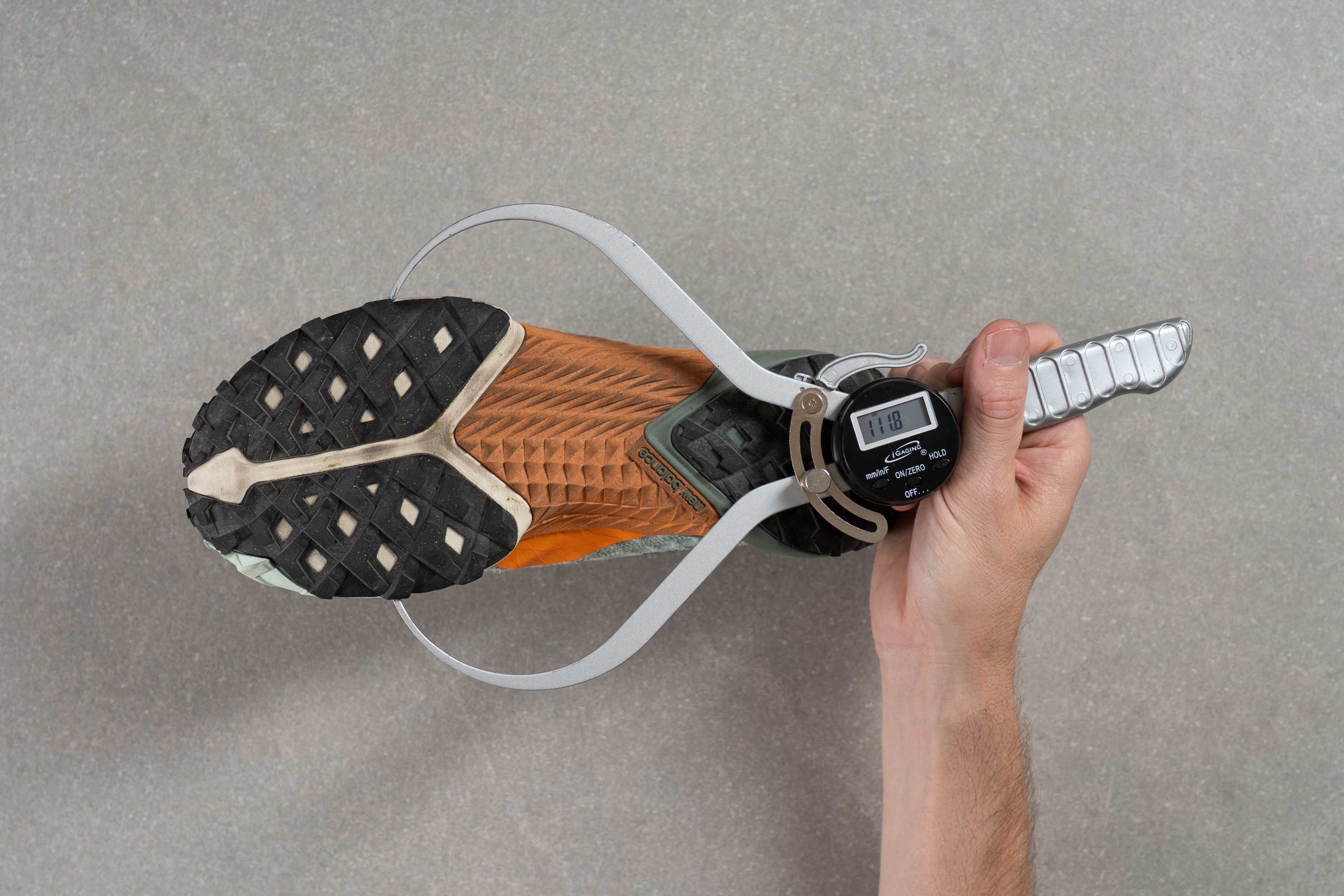
| Minimus Trail | 111.8 mm |
| Average | 112.8 mm |
Midsole width - heel
At 80.6 mm, the design is strikingly aggressive, almost resembling a track spike. We believe it works well here, since a wider rearfoot would have made the shoe feel too much like a standard trail model.
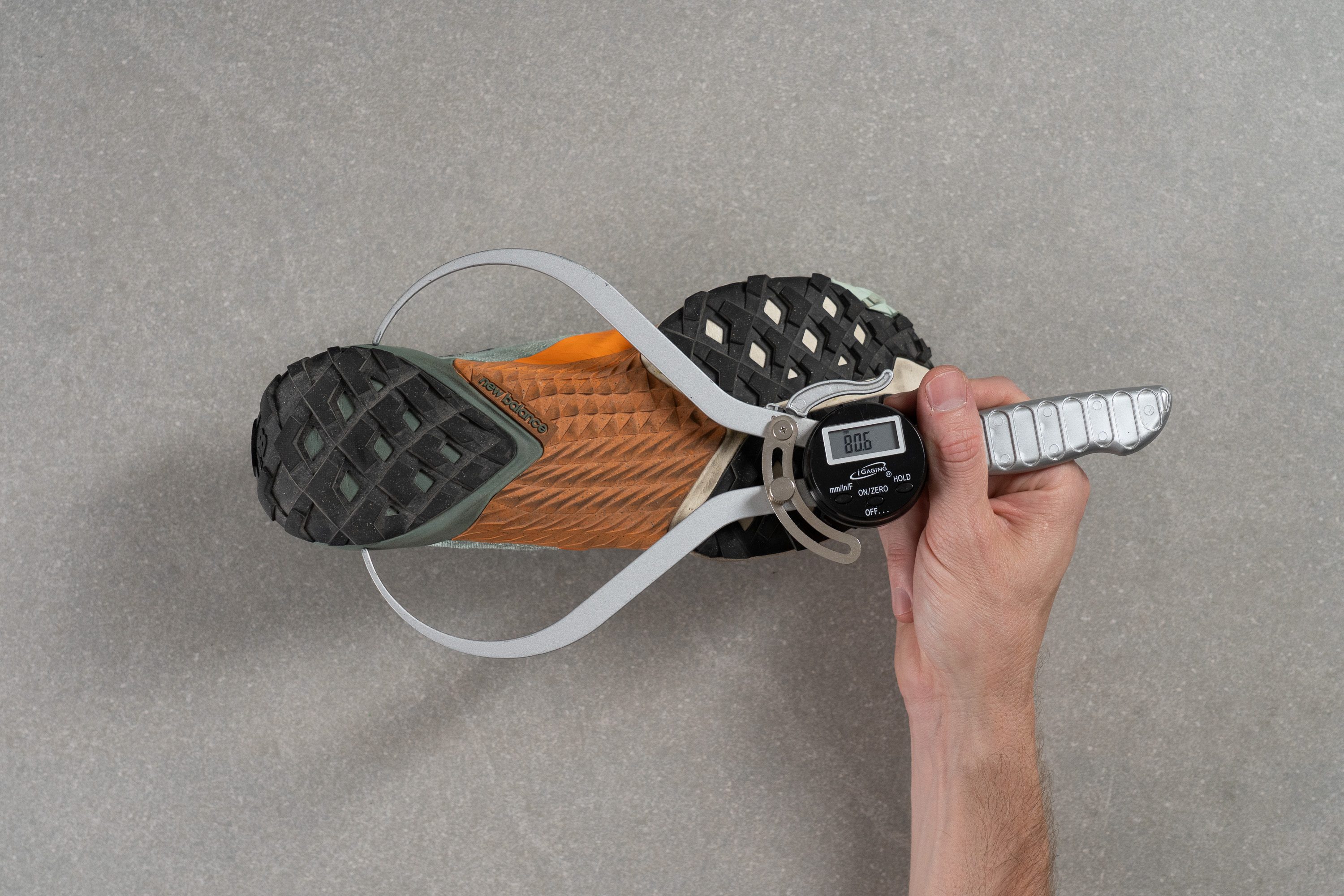
| Minimus Trail | 80.6 mm |
| Average | 89.8 mm |
Durability
Toebox durability
We had many reasons to believe that New Balance went all-in for durability with the Minimus Trail, and here we tested it directly. The rugged, extra-durable upper proved its strength with ease, showing impressive resilience and earning a 5/5.
| Minimus Trail | 5 |
| Average | 3.1 |
Heel padding durability
The heel padding also performed above average in durability with a 4/5, leaving no concerns in this area.
| Minimus Trail | 4 |
| Average | 3 |
Outsole durability
To make things even better, the AT Tread outsole showed excellent durability with just 0.6 mm of wear. This confirms the Minimus Trail avoids early wear issues both on the upper and the outsole.
| Minimus Trail | 0.6 mm |
| Average | 0.9 mm |
Outsole thickness
The outsole measures 2.9 mm in thickness, which may feel slightly excessive for a minimalist shoe especially given its excellent durability. On the positive side, this added material provides extra protection against potential hazards.
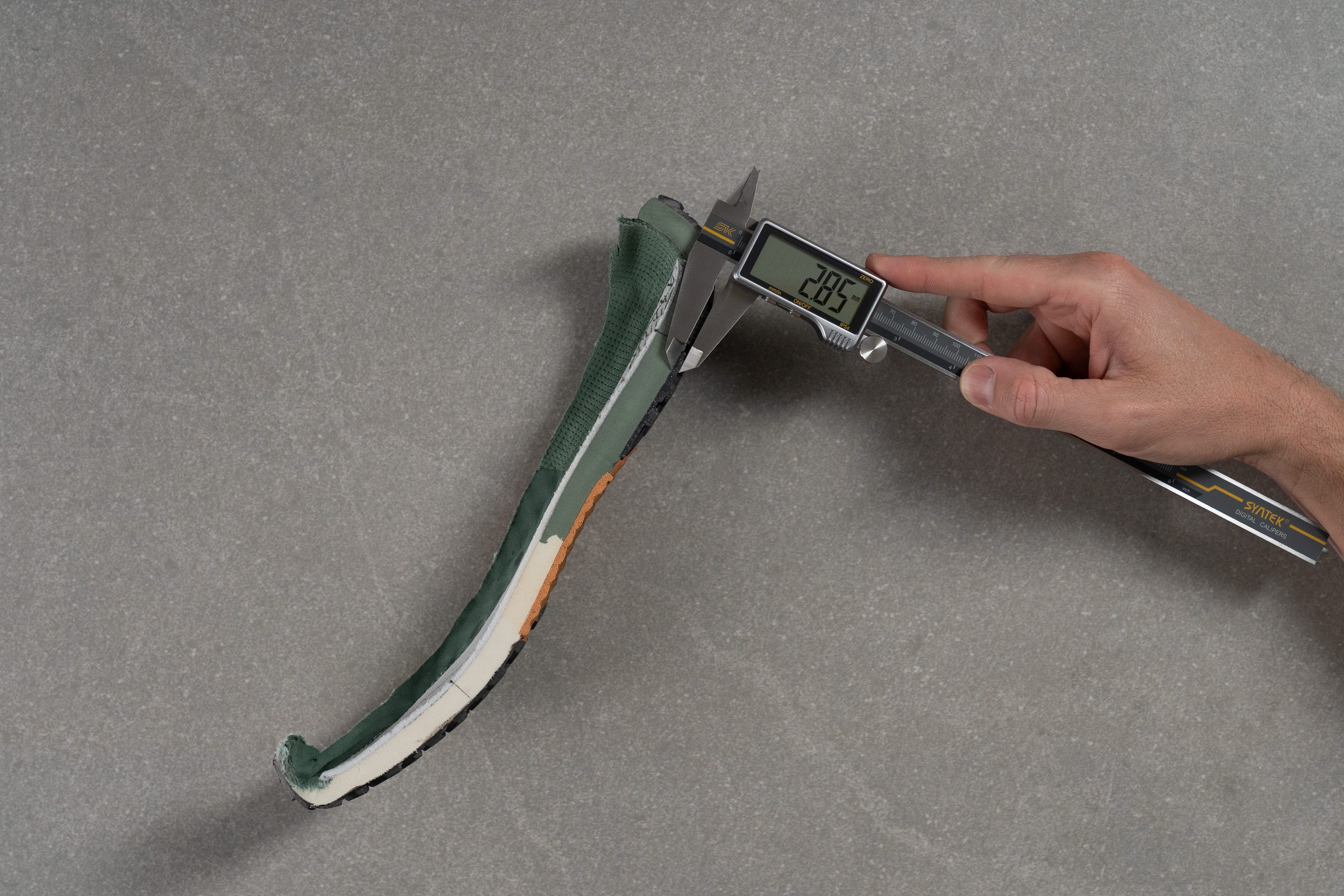
| Minimus Trail | 2.9 mm |
| Average | 2.2 mm |
Misc
Removable insole
It’s uncommon to see a non-removable insole these days, a feature usually found in certain supershoes. However, New Balance clearly intends for runners to stick with the insole provided in the Minimus Trail.
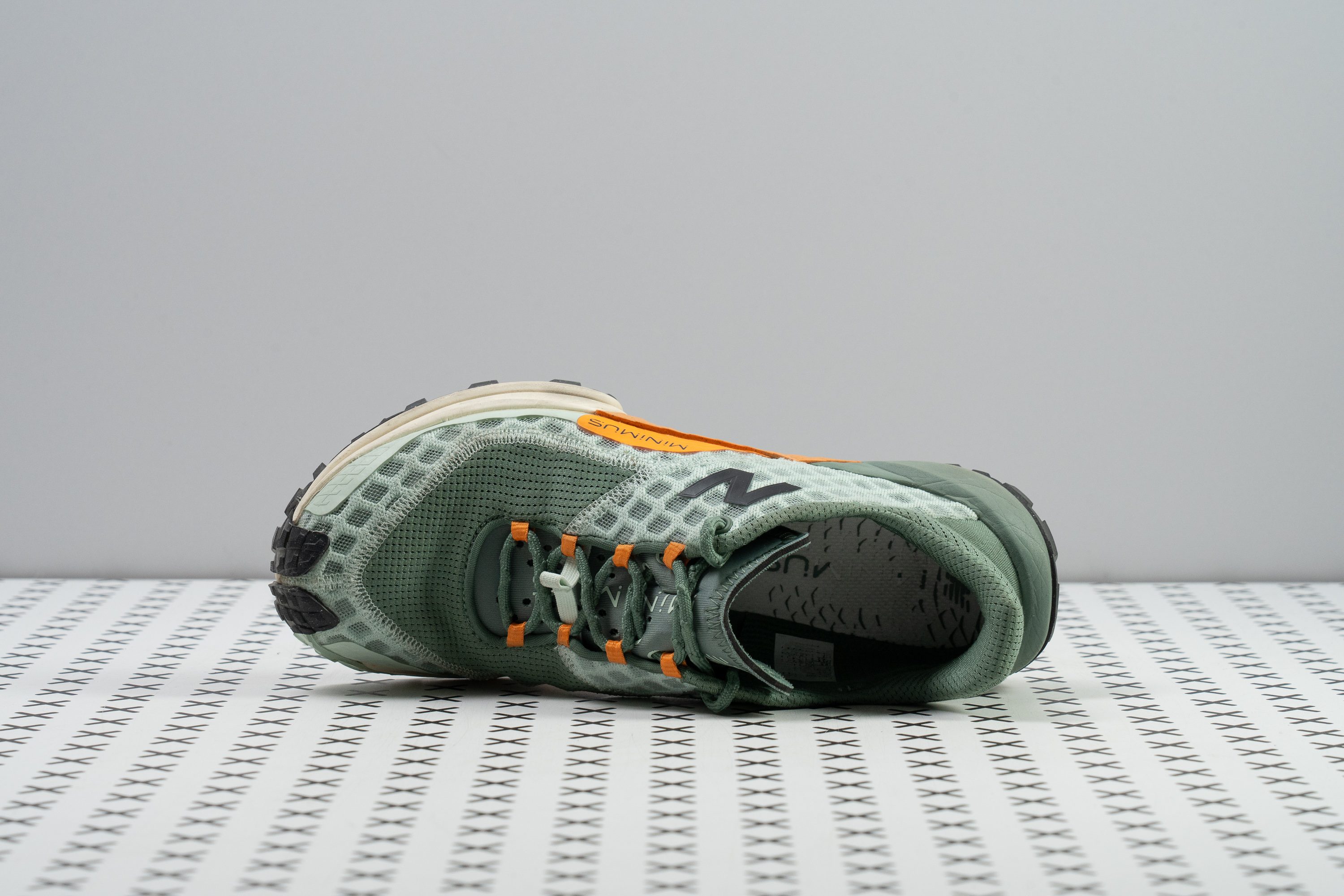
| Minimus Trail | No |
Midsole softness in cold (%)
The FuelCell midsole became noticeably firmer after 20 minutes in our freezer, with softness dropping by 44% to reach 22.5 HA.
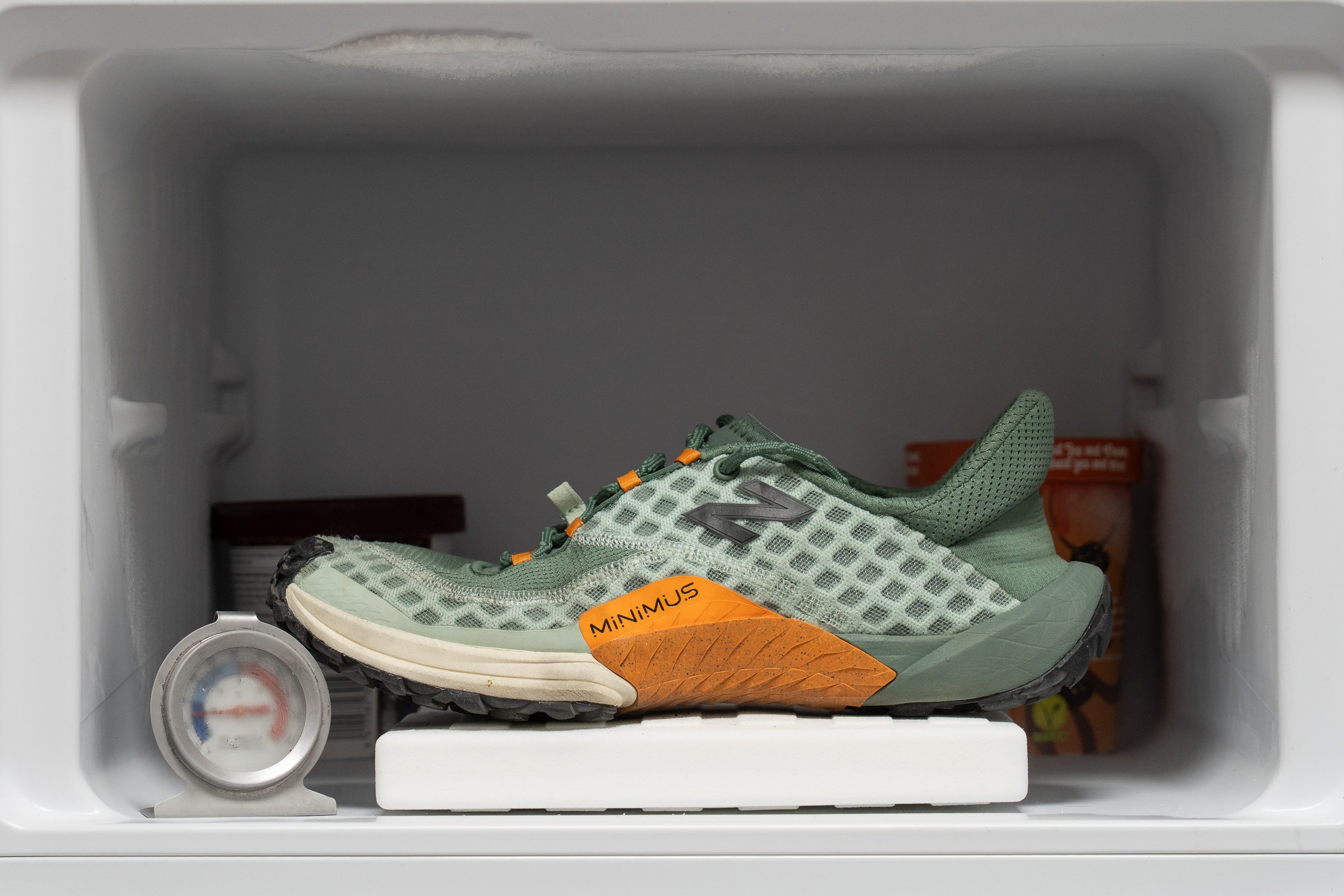
| Minimus Trail | 44% |
| Average | 26% |
Reflective elements
The Minimus Trail lacks reflective elements, which can be disappointing for runners heading out on the trails very early in the morning or later in the evening.
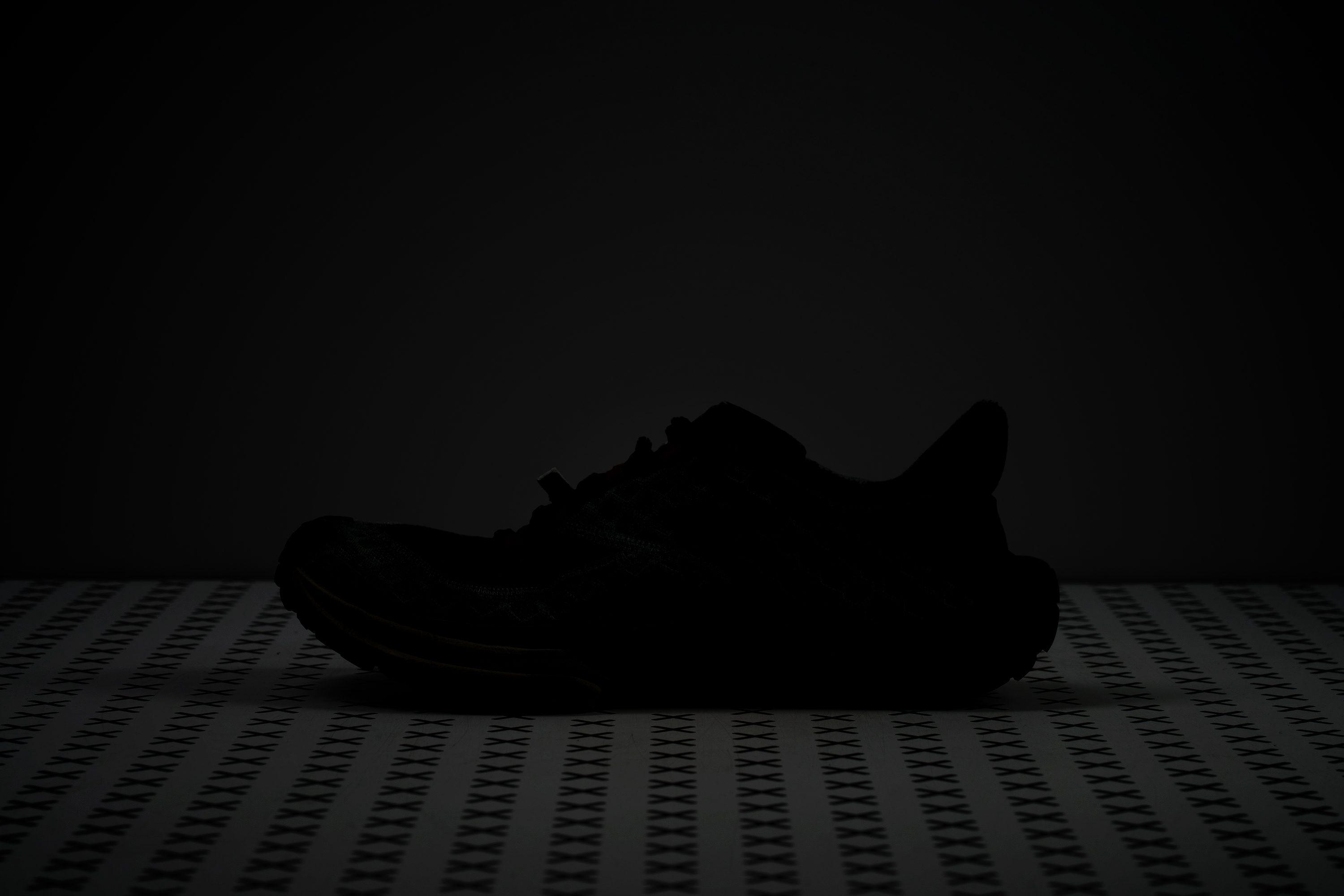
| Minimus Trail | No |
Tongue padding
This is definitely not the most conventional lacing system. The orange lace loops and single top eyelet help distribute pressure, though the rounded laces may not appeal to everyone. But its standout feature is the tongue loop, where the laces pass directly through the tongue itself.
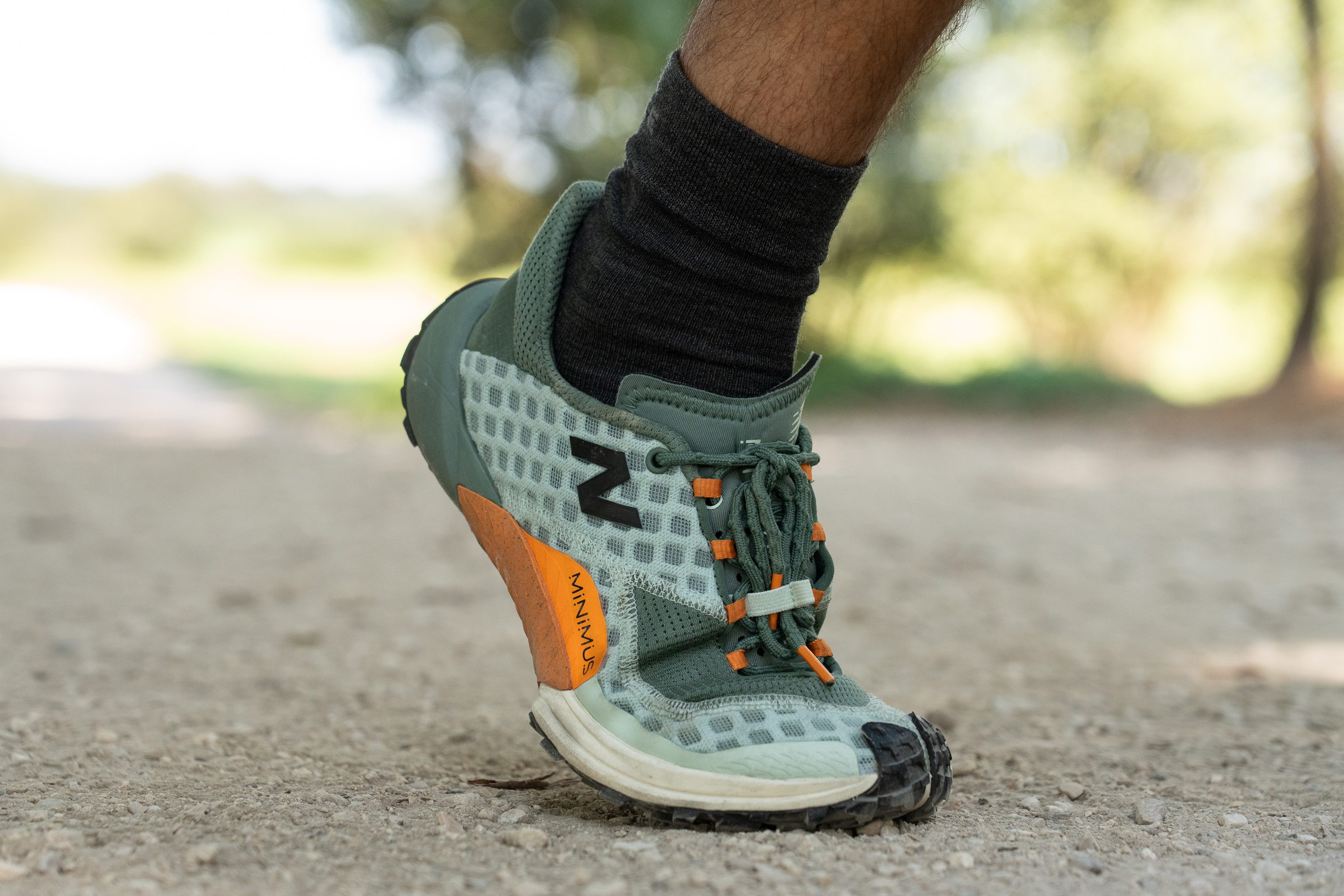
The tongue of the Minimus Trail is lightly padded, measuring only 2.0 mm, so it has minimal foam. Be sure to tighten the laces carefully to prevent any discomfort on the instep.
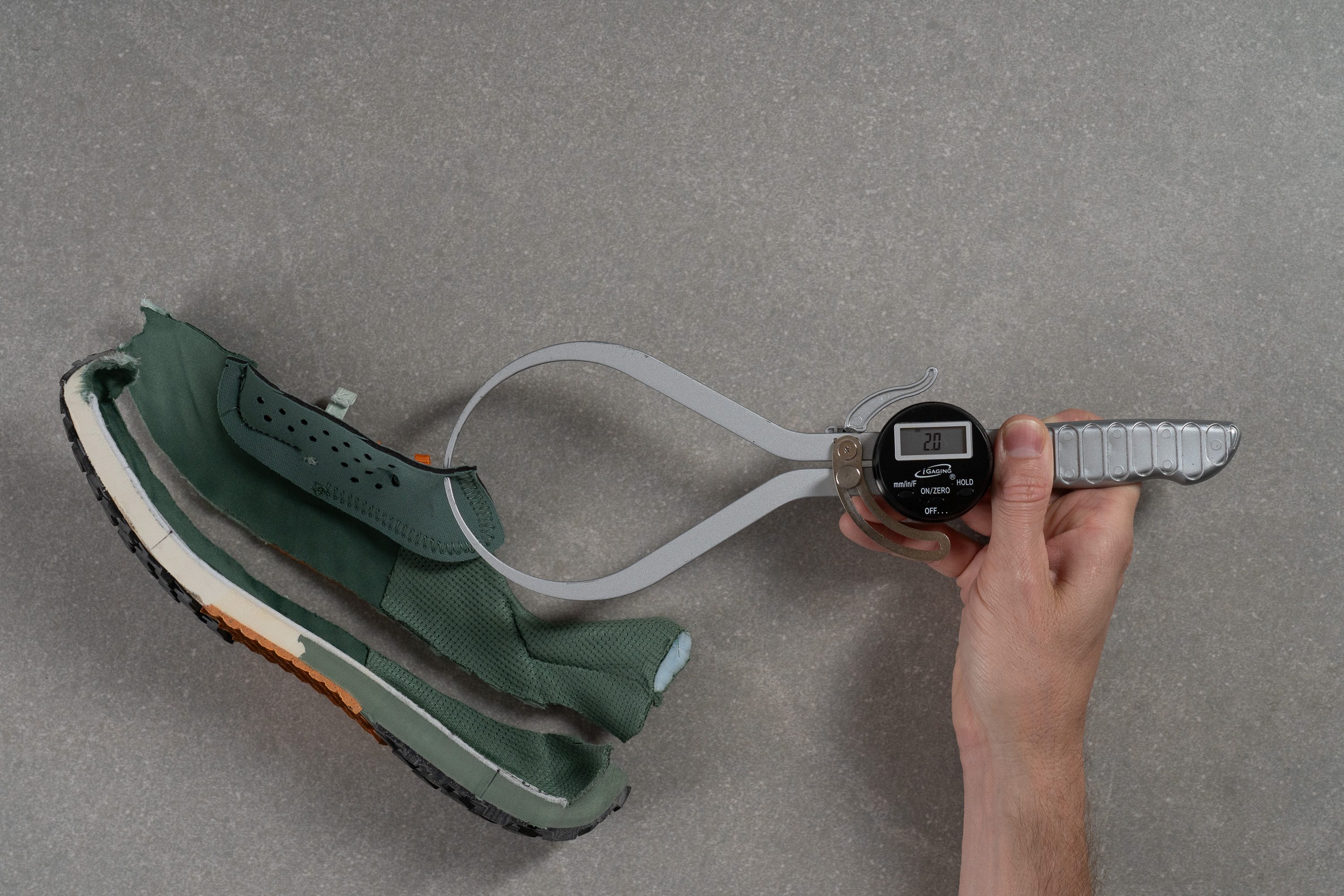
| Minimus Trail | 2.0 mm |
| Average | 6.4 mm |
Tongue: gusset type
Unlike most trail shoes, this one lacks fabric connecting the tongue to the sides. This can be a drawback, as it may allow small debris to enter the shoe more easily.
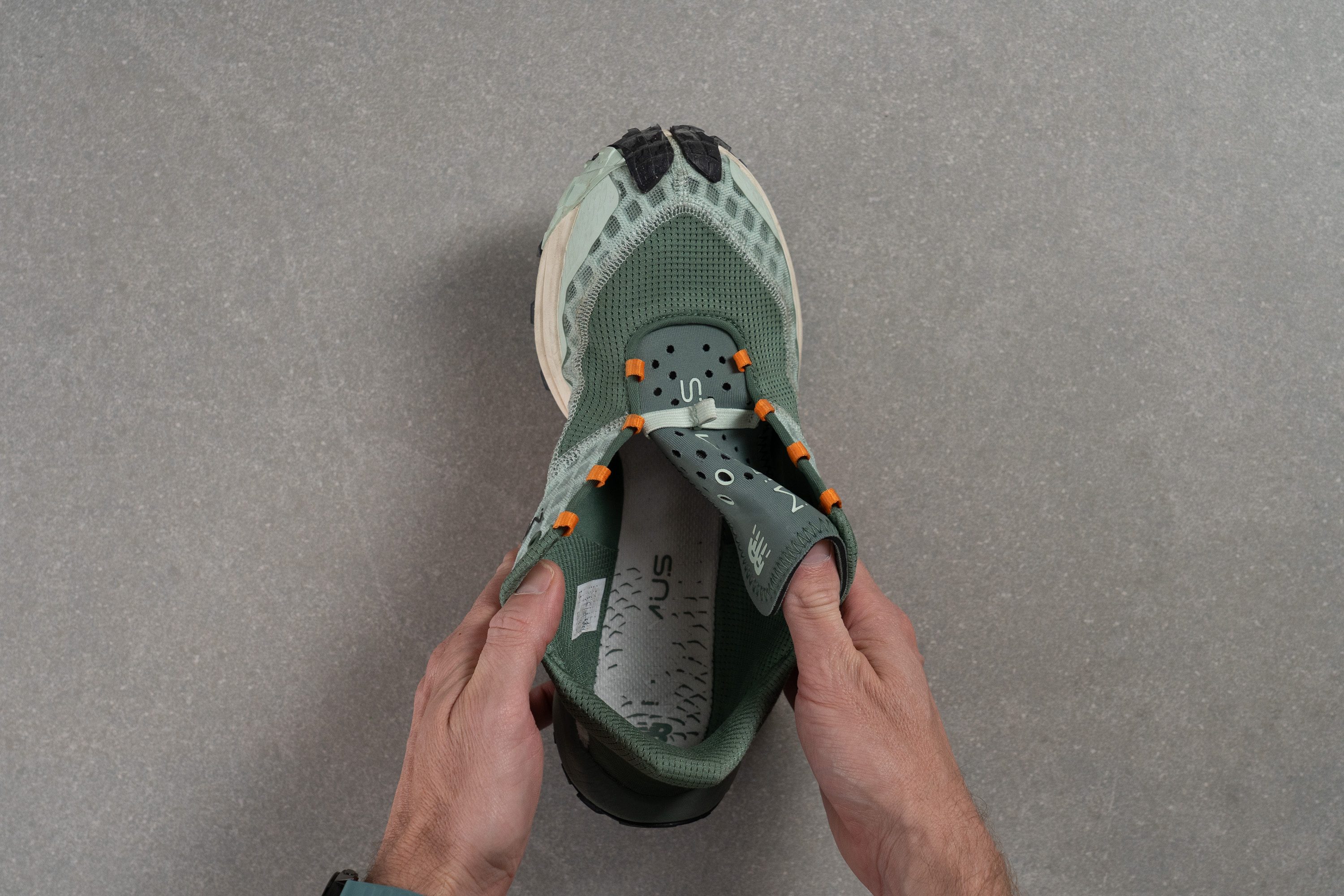
| Minimus Trail | None |
Price
In our view, the Minimus Trail is fairly priced. Many assume minimalist shoes should be very cheap, but that’s not true, as the only real difference is less midsole stack, while the rest matches any other running shoe.
| Minimus Trail | $120 |
Heel tab
The heel collar of the Minimus Trail is soft and made from a stretchy fabric that flexes easily when pulled. A nice touch!
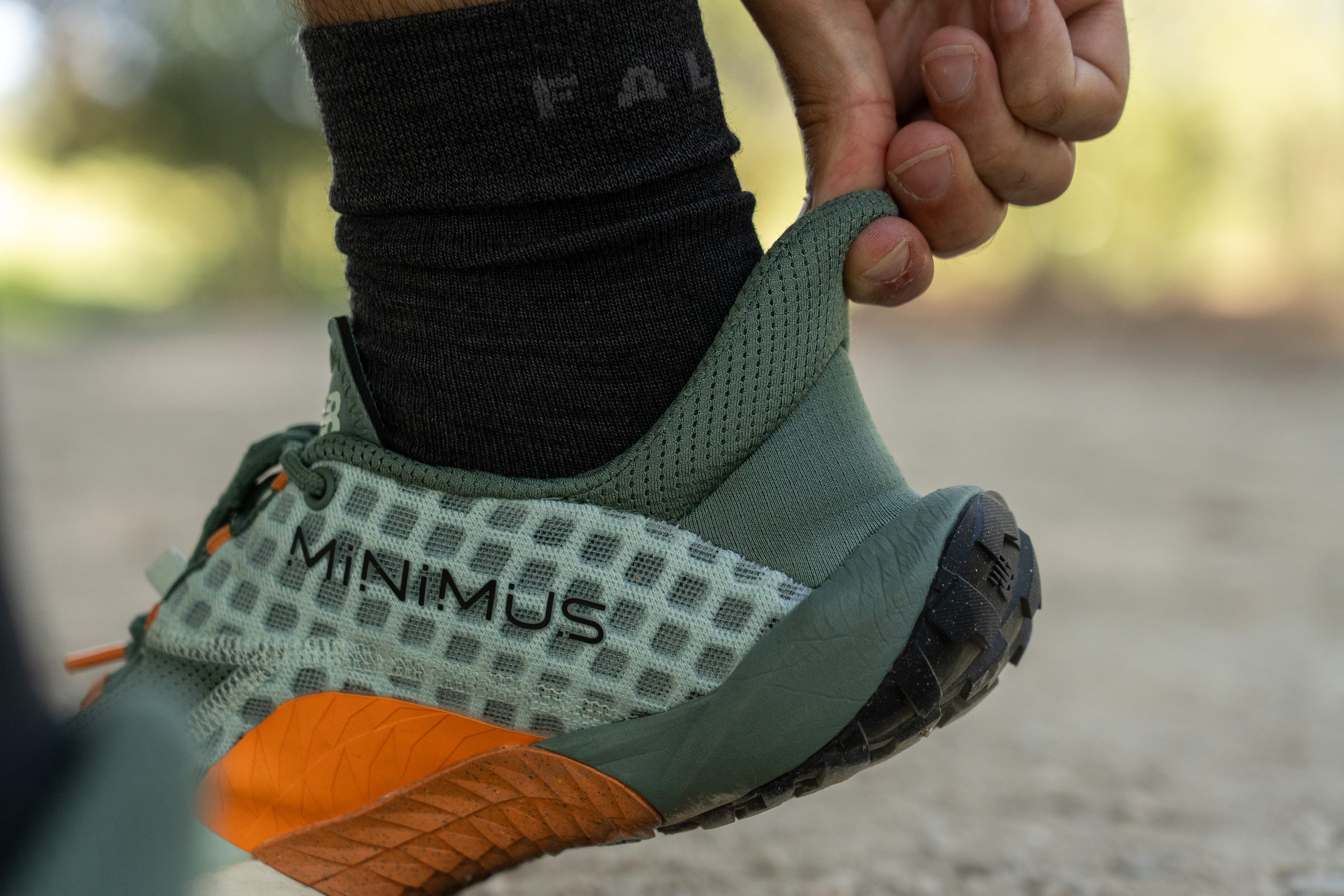
| Minimus Trail | Extended heel collar |
Tongue loop
Another nice detail on the tongue is the elastic loop, which makes it easy to secure the laces and keep them from shifting around.
